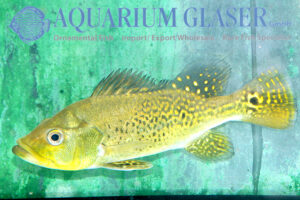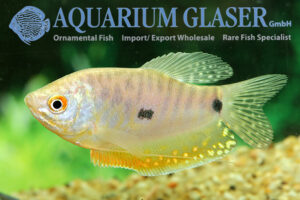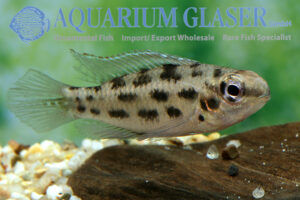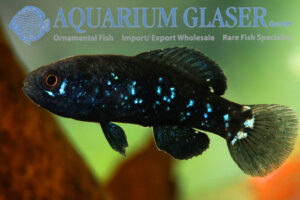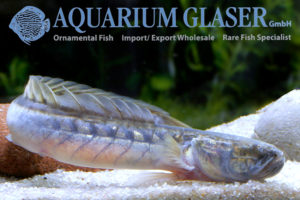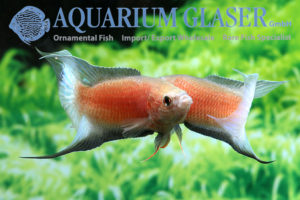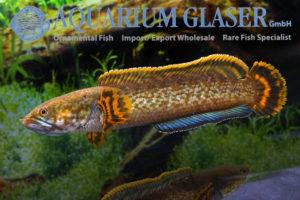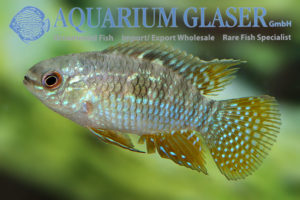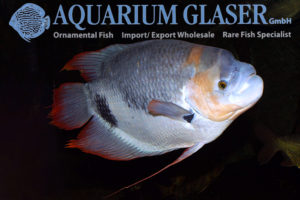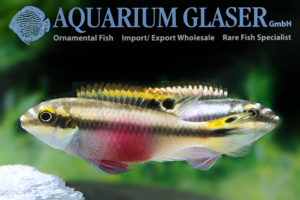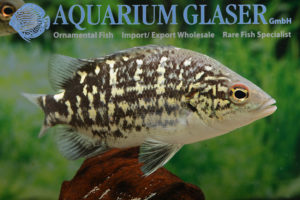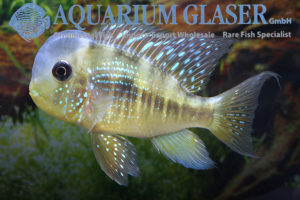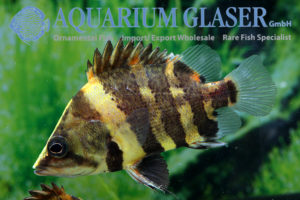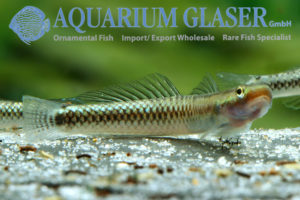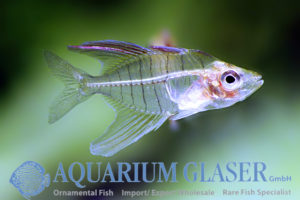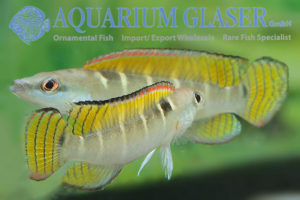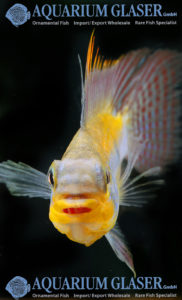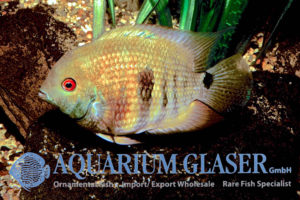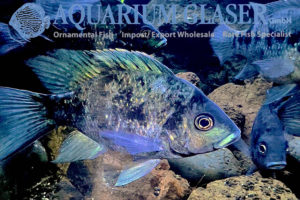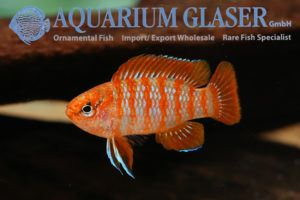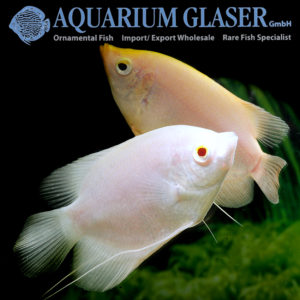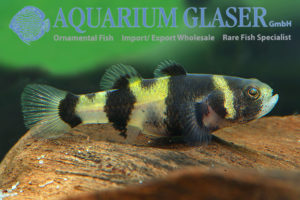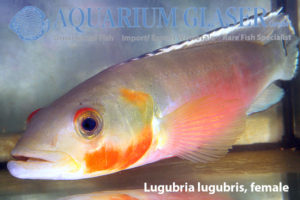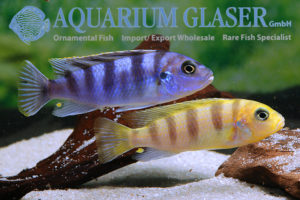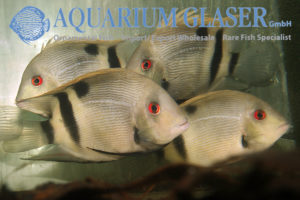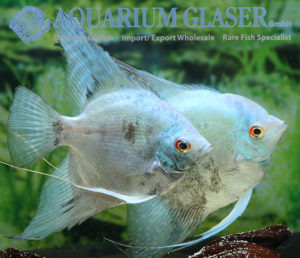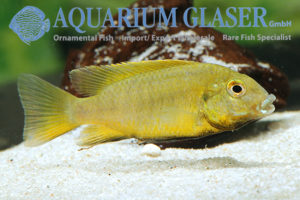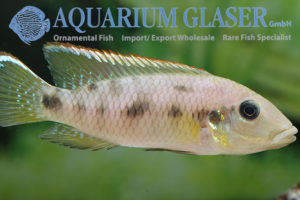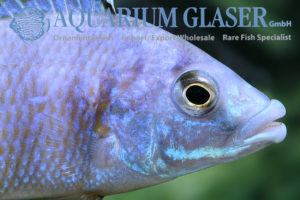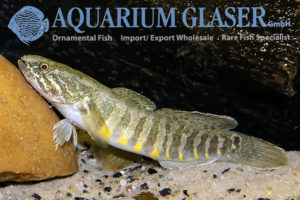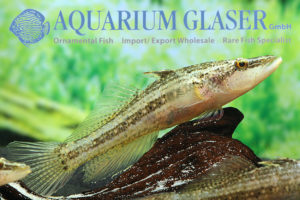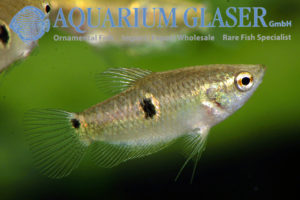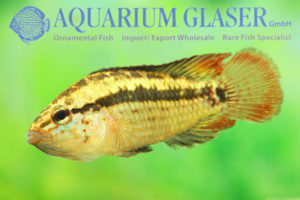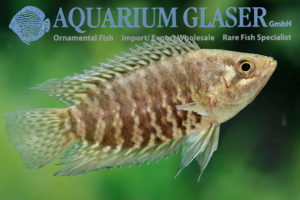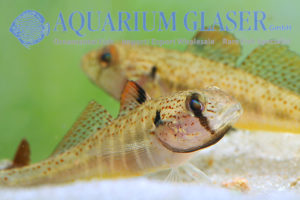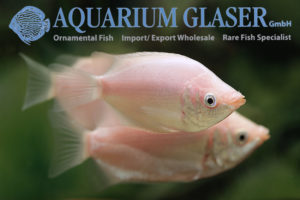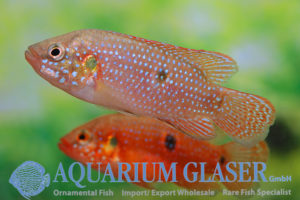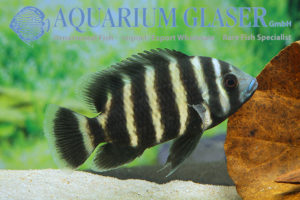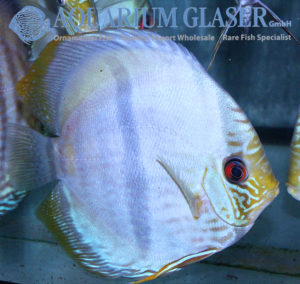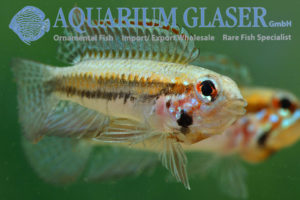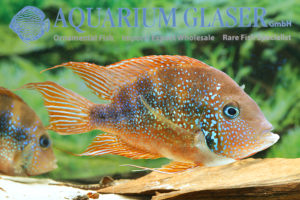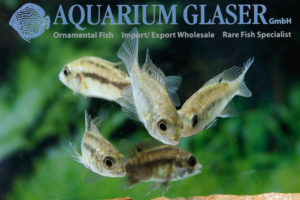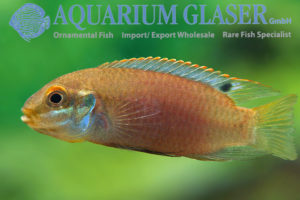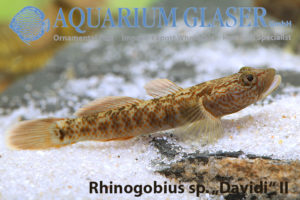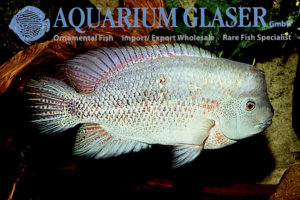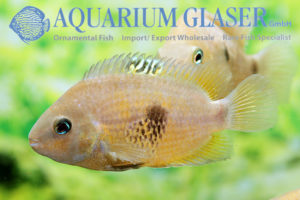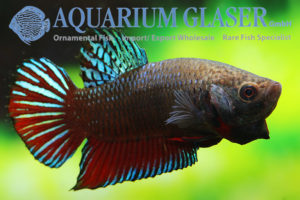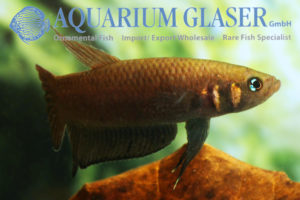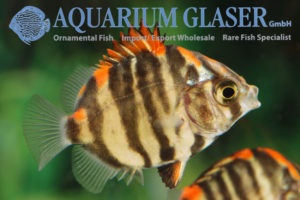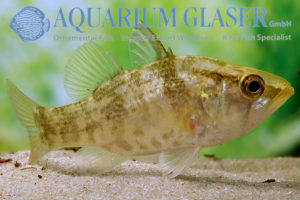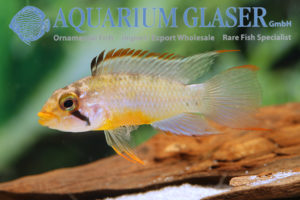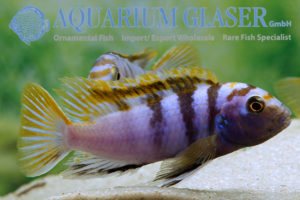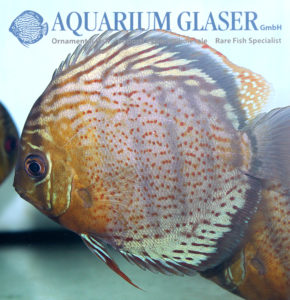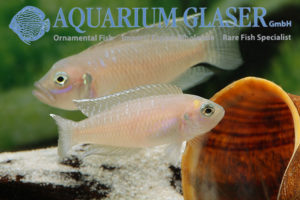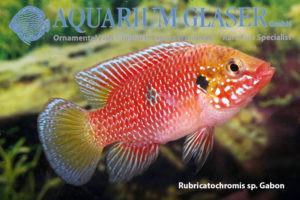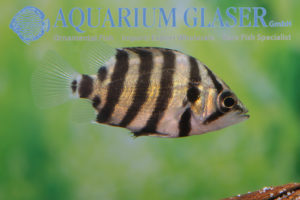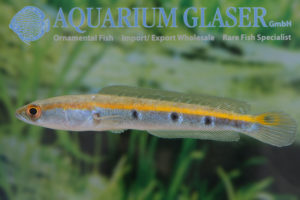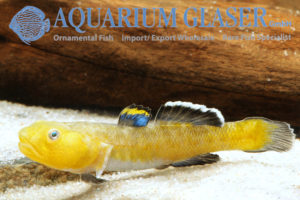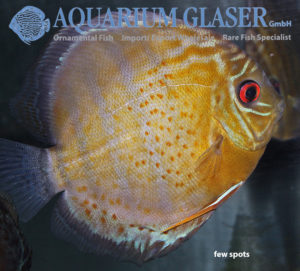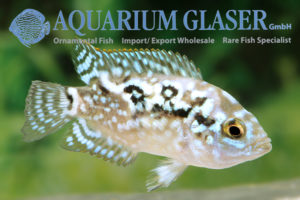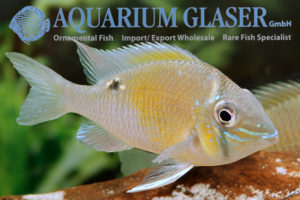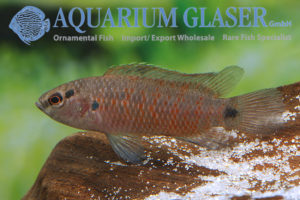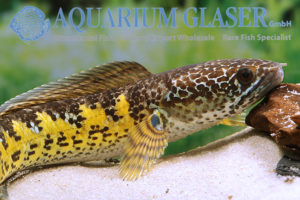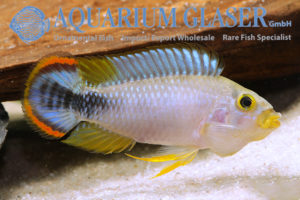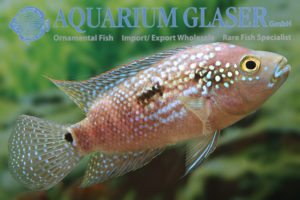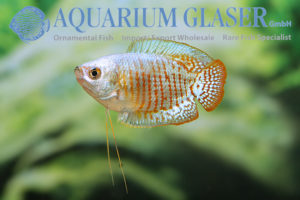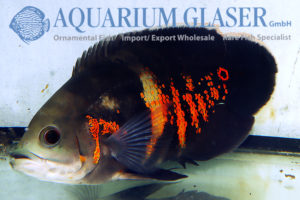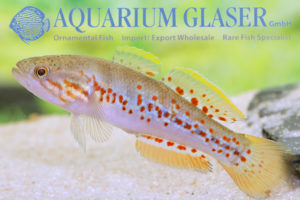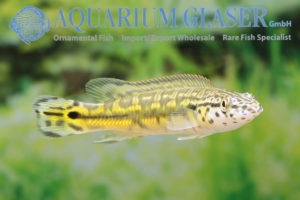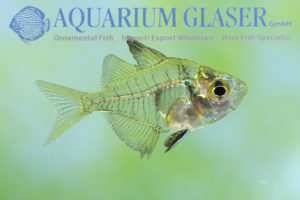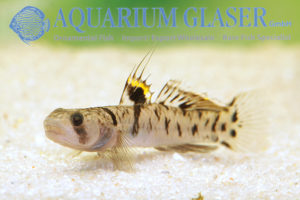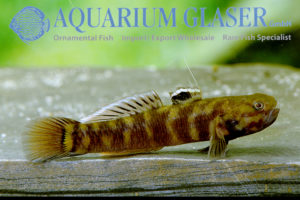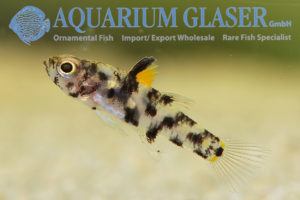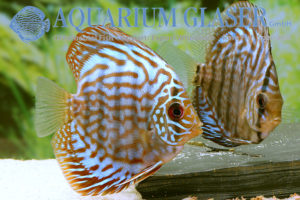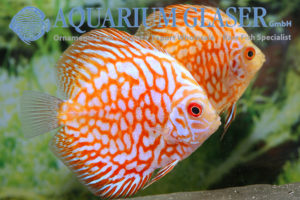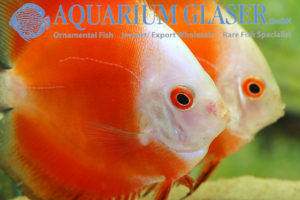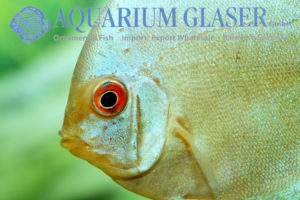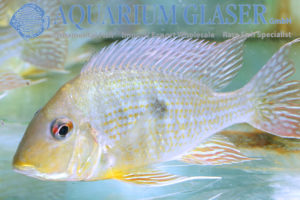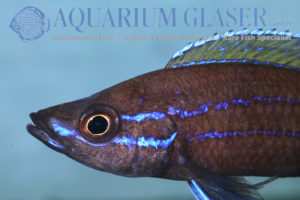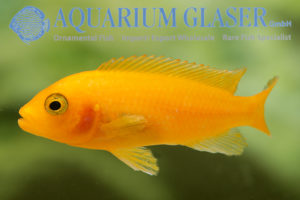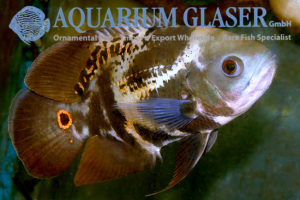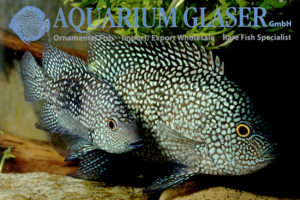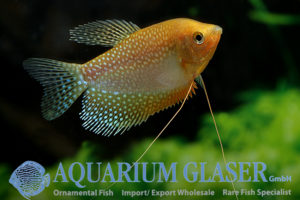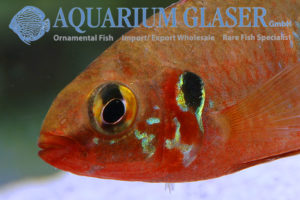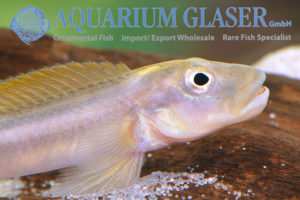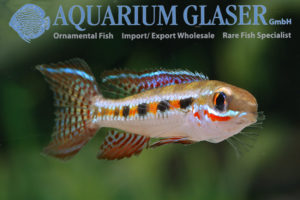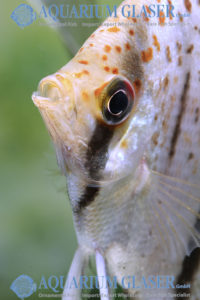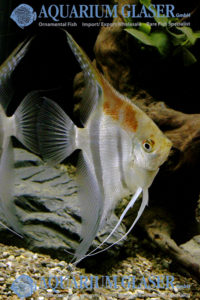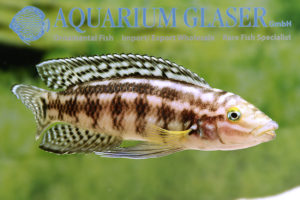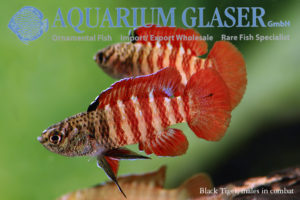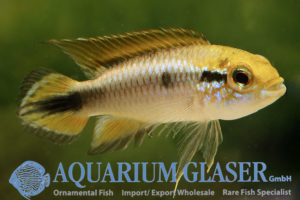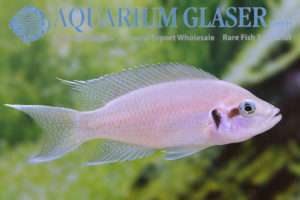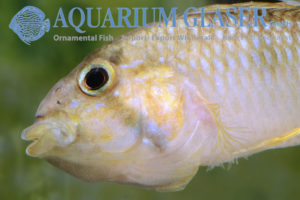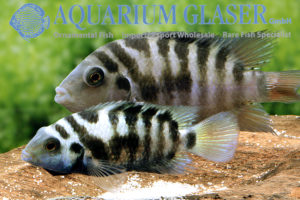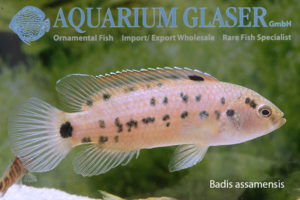Just a few decades ago, the Peacock Basses from South America (genus: Cichla) were considered almost unsustainable for aquaria, but nowadays they are bred regularly and in large numbers. The latest craze is Cichla kelberi “Spider”, a breeding form whose origin is not yet known. The photos show our current stock, 16-18 cm long specimens, […]
25. Perchlike fishes (905)
-
-
Trichogaster trichopterus ( = Trichopodus t.)
The spotted gourami is one of the most important ornamental fish of all and is one of the top 100 worldwide. The species is extremely widespread in Southeast Asia. Despite its relatively small size (usually 8-10, rarely up to 15 cm), this gourami is used as a food fish and can survive for a long […]
-
Dicrossus warzeli Bred
The rarest of all checkerboard cichlids in the aquarium is Dicrossus warzeli, which was known as Dicrossus or Crenicara sp. Tapajós before its scientific description. In 1992 the very characteristically marked dwarf cichlid was discovered in an unnamed tributary (Igarapé) of the great Rio Tapajós in Brazil by the traveling aquarist Frank Warzel and brought […]
-
Elassoma evergladei
The Pygmy Sunfish, Elassoma evergladei, is a classic dwarf fish and has been maintained and bred for many generations of aquarists. The species is best housed in a small species aquarium that does not require heating. The cute fish, growing only 2-3 cm, are completely peaceful, however the males defend an individual area against conspecifics. […]
-
Gobioides broussonnetii
Only rarely we can offer the dragon fish, Gobioides broussonnetii, which actually is a species of goby. Now we received once again from Colombia this strange bottom dweller. The maximum length of the species is said to be about 40 cm. They are absolutely peaceful plankton eaters, which should be offered fine sandy substrate in […]
-
Macropodus opercularis: squeaky red!
Solid red paradise fishes (Macropodus opercularis) have been known since the 1990s. However, they could not really establish themselves in the market, because the animals, which were also traded under the fancy name “Macropodus rex”, turned out to be very susceptible to diseases. Apparently the problem has been solved and we have now received really […]
-
Channa brunnea
The Rainbow Snakehead (Channa bleheri) is without doubt one of the most beautiful and colorful snakeheads and with usually 12-15 cm total length (sometimes a bit more) it stays quite small. It originates from the north of India and belongs to the few Channa species without ventral fins. Since 2007 a very similar, also colorful […]
-
Laetacara curviceps
Long before the Apistogramma species became popular, another dwarf cichlid from Brazil captured the hearts of aquarists: Laetacara curviceps, the Flag acara. At that time it was still called Aequidens curviceps. For some time it has unfortunately become quiet around him. Now we have once again received beautiful offspring of this small, peaceful and beautiful […]
-
Osphronemus laticlavius
Once again we received the rare red-finned giant gourami (Osphronemus laticlavius). Like the common giant gourami this species grows around 60 cm long. The home of the fish is on Borneo, where it probably occurs naturally only in Sabah, i.e. in the very north of the island in the Malayan part. Since about 1985 this […]
-
Pelvicachromis pulcher wild yellow
The yellow color variety of the species P. pulcher comes from southwestern Nigeria, where it is collected west of the Niger Delta in the Ethiop River area. The additional color designations yellow, red and green refer to the gill covers in P. pulcher, they all get red bellies. In all Pelvicachromis, females are considerably more […]
-
Hephaestus habbemai
New fish, new questions. This is how we could characterize our import of the grunter Hephaestus habbemai. These beautiful fish come to us from Indonesia and originate from the island of New Guinea. Originally (1910) they were described from the south of the island, from the Lorentz River. The species is a pure freshwater inhabitant; […]
-
Gymnogeophagus balzanii
The hump of the male of G. balzanii is comparable to the feather tail of a peacock: it is simply the expression of manhood! The Paraguay Eartheater originates from the southern parts of South America and is imported now and then from Paraguay as wild collected stock, but the species is also bred on a […]
-
Datnioides campbelli
Among lovers of large, predatory fish, the species of the genus Datnioides (formerly: Coius) enjoy great popularity. They are calm, expressive fish that, after a sometimes somewhat tough acclimation period in which they are shy and skittish, become very attached to the keeper and provide decades of enjoyment. All Datnioides species grow to 30-40 cm […]
-
Stiphodon atropurpureus
The neon gobies of the genus Stiphodon are all beautiful fish. None of the 37 currently known species grows longer than 5-7 cm, usually they remain much smaller. Although adult Stiphodon live exclusively in pure freshwater, the larvae can only develop in the sea. Therefore, neon gobies live in streams near the coast. They spawn […]
-
Gymnochanda ploegi
We have received this dwarf glass perch from Indonesia, which was named in honour of Alex Ploeg, who was in the passenger plane shot over the Ukraine on 17 July 2014. Gymnochanda ploegi is known so far only from West Kalimantan, the part of Borneo belonging to Indonesia. It is a pure freshwater species that […]
-
Wallaciia compressiceps (= Crenicichla c.).
The dwarf spezies among the pike cichlids have recently been separated as an independent genus Wallaciia (see https://www.aquariumglaser.de/en/fish-archives/the-crenicichla-have-been-reclassified/). They include W. compressiceps, which occurs only in the Tocantins and Araguaia rivers in Brazil. It is one of the smallest, the prettiest and the most aggressive pike cichlid species. Although it only grows to a maximum […]
-
Apistogramma allpahuayo (2)
From Peru a beautiful dwarf cichlid regularly comes to us, which is called “Apistogramma juruensis” on the exporter´s lists. The animals are very similar to A. cacatuoides and to A. juruensis, but can usually be easily distinguished from both by one coloration feature: a black chin spot, which was decisive for the common trade name […]
-
Heroina isonycterina
It does not always have to be bright colors that make a fish interesting. Rather, it appeals to nature lovers to study the life history of the animals they keep and this often leaves a deeper impression in the long run than the colorful appearance. By cichlid standards Heroina isonyterina is a gray mouse. However, […]
-
Ptychochromis oligacanthus
Of the cichlids endemic to Madagascar, Ptychochromis oligacanthus is also quite well known aquaristically by name. However, the understanding of what is meant by this species has changed thoroughly only a few years ago (2006). Previously it was believed that the species was widespread and divided into four different colored races. Today these races are […]
-
Dario dario
The Dwarf Badis, also called Scarlet, has transformed itself from the highly paid sensation of the year 2000 to the always available classic in aquaristics. It originates from northern India (North Bengal), where it inhabits clear, moderately flowing waters with sandy bottoms and rich underwater plant growth at the foot of the Himalayas. In terms […]
-
Osphronemus goramy gold and albino
Labyrinth fishes are among the most important ornamental fishes in the world. Their often bright colors and varied behavior make their care very rewarding. Most species also remain small, only very rarely exceeding the 10 centimeter mark. The exception are the giant gouramis (Osphronemus), of which there are four accepted species. They are not only […]
-
Brachygobius sabanus Vietnam
From Vietnam we received this very nice bumble bee goby. The identification of bumble bee gobies is still in many cases a very tricky matter and often succeeds only with many question marks. Brachygobius sabanus was originally described from Borneo (Sabah), but our animals originate from Vietnam. However, the figure attached to the first description […]
-
The Crenicichla have been reclassified
With 93 accepted species, the pike cichlids (Crenicichla) are the most species-rich genus of cichlids anywhere. Closely related to Crenicichla are the Teleocichla cichlids. The relationship is so close that the independence of Teleocichla has been doubted several times. In a recent study in which 74 species of the complex could be considered (65 Crenicichla […]
-
Maylandia lombardoi
Who remembers art class in school? Among the first things you learn are color temperatures, right? According to this, red, yellow and orange are warm colors, while blue, green and purple are cool colors. In Lake Malawi’s rock cichlids, the mbuna, the territory-owning males usually shine in cool colors (usually blue), and the females exhibit […]
-
Uaru fernandezyepezi
In the Rio Atabapo in Venezuela, from which Uaru fernandezyepezi originates, it is already some weeks closed season, i.e. no fish may be caught there. The beautiful Uaru fernandezyepezi, which we can offer at the moment, are therefore the last specimens of the current season. There was a time when people hardly dared to import […]
-
Pterophyllum Blue Angelfish 2023
Solid blue-green angelfish are apparently the dream of many angelfish breeders. The body base color blue, a mutation, has been known in angelfish since World War 2, but it was very difficult to establish it in large-scale breeding. It was not until the end of the 1990s that this was achieved. Since then, a wide […]
-
Coptodon gutturosus
Cichlids form new species comparatively quickly when placed in geographic isolation. For them, the speciation process often takes only a few decades or centuries, whereas other groups often need millennia. Lake Bermin in Cameroon is a comparatively tiny crater lake with a surface area of only 0.6-0.7 km2. The lake is located in a former […]
-
Chromidotilapia kingsleyae
The wonderful West African cichlids have been somewhat forgotten in recent decades. In the 1970s and 1980s, on the other hand, they experienced a real boom and a great many new species were discovered at that time because ornamental fish collectors were only too happy to fulfill the aquarists’ desire for previously unseen cichlids. Many […]
-
Placidochromis milomo
Lake Malawi in the heart of Africa is home to an enormous variety of cichlids. Often it is difficult to decide whether in individual cases they are different species or local variants. Extremely popular in aquaristics are the rock cichlids (Mbuna). But also among the non-Mbuna, which in their habitat are not so dependent on […]
-
Bostrychus zonatus
Bostrychus zonatus is a sleeper goby and becomes about 15 cm long. They are predatory fish, which should therefore only be kept together with species that have at least half the body length of the gobies, larger is safer. The beautiful animal is widespread in fresh and brackish water in New Guinea and northern Australia. […]
-
Butis gymnopomus
Sleeper gobies the genus Butis (there are 6 recognized species) belong to the most original members of their kind. They swim around in the aquarium in every imaginable posture, especially often with the belly up, but also upside down or with the snout up. Thereby they imitate a floating piece of wood and are not […]
-
Parasphaerichthys ocellatus
This extremely rarely imported species originates from Burma. The charming fish attains a length of only 2-3 cm. The species is a close relative of the mouthbrooding chocolate gouramis, but P. ocellatus is a bubblenest builder although the eggs look like the eggs of mouthbrooders. In the habitats of P. ocellatus appear heavy day-night changes […]
-
Apistogramma kullanderi
The “Giant Apistogramma” caused a flurry of excitement when it was discovered in 2009 during an expedition to the Serra do Cachimbo (Pará, Brazil). The discoverers, J. L. O. Birindelli and M. Sabaj Perez, reported on this great fish in various journals, initially under the name A. sp. “Gigas”. Then in 2014, Varella and Sabaj […]
-
Microctenopoma fasciolatum
Unfortunately imports from the Congo are only rarely possible. But now it was once again so far and among other species we have received nice wild catches of the Banded ctenopoma (Microctenopoma fasciolatum, formerly Ctenopoma f.). The currently imported form – the exact locality is unknown to us – differs quite clearly in color from […]
-
Sineleotris saccharae
From the Hong Kong area comes this beautiful, but also delicate goby. The maximum length of the species is about 10 cm. The basic temperature requirements are well known from the White Clouds (Tanichthys albonubes), which occurs in the same region: 16-22°C for normal care, somewhat higher for breeding, short-term up to 28°C are tolerated. […]
-
Helostoma temmickii
The kissing gourami (Helostoma temmickii) in its pink breeding form is one of the best known labyrinth fish. It is not actually bred as an ornamental fish, but as a food fish. The species grows up to 30 cm long under suitable (fattening) conditions and is considered delicate. In the nutrient-rich, turbid breeding ponds, the […]
-
Rubricatochromis “lifalili” (formerly: Hemichromis)
There is no doubt about it: the Red Jewel Cichlids, formerly called Hemichromis bimaculatus, are among the most popular aquarium fishes. For several generations of mankind they have been swimming in the aquariums of the world and find again and again new, enthusiastic followers – however also aquarists who swear an oath: never again Red […]
-
Heterotilapia buettikoferi (formerly: Tilapia b.).
The large cichlids of South and Central America have a firm place in aquaristics. However, aquarists have a mental problem with the no less magnificent large cichlids of Africa. When the name “tilapia” is mentioned in a fish discussion, everyone immediately thinks of gray underwater lawnmowers with carp format. There is a grain of truth […]
-
Symphysodon discus “BLUE MOON”.
The Real or Heckel Discus (Symphysodon discus) is always somewhat behind its close relatives, the Blue and Green Discus, in popularity. This is certainly only because it breeds less willingly. There is no doubt about its special beauty. The Heckel Discus “Blue Moon” is found only in a rather remote region of the Alto Nhamunda […]
-
Apistogramma psammophila
The two-banded dwarf cichlid, Apistogramma diplotaenia, is one of the dream fish of many Apistogramma lovers. The species originates from the Rio Negro drainage in Brazil. Unfortunately, this fish is also one of the most demanding species of the genus and even minor carelessness – e.g. a missed water change and the resulting increase in […]
-
Thorichthys aureus
The “golden cichlid” is one of the first cichlid species that became known for aquaristics. It originates from Mexico. Already in 1911 the first imports took place. However, the species never really caught on in general, in contrast to its cousin T. meeki, which was first imported more than 20 years later and is still […]
-
Ptychochromis insolitus
One of the rarest animals in the world is this Madagascar cichlid, which was only scientifically described in 2006 and already in 2013 it was feared to be extinct. It existed in only one river on Madagascar, the Mangarahara, after which the perch is also called Mangarahara cichlid. A dam project and excessive water extraction […]
-
Enigmatochromis lucanusi
After many years we received again this beautiful pastel colored dwarf cichlid from Guinea. Only in 2009 the species, which belongs to a group of species popularly also called king cichlids, was scientifically determined, before it was known in the hobby as “Pevicachromis sp. aff. roloffi Blue Fin”. The females of this species show – […]
-
Rhinogobius sp. “Davidi”
We have the great ambition to open up new species for aquaristics again and again. Therefore it is not excluded that we also import species whose scientifically exact determination is not successful, because simply not enough scientific research has been done about the animals so far. The extremely species-rich genus Rhinogobius is a good example […]
-
Vieja breidohri
The 1980s and 1990s were the high times of traveling aquarists who wanted to shed light on Central American cichlids. And this succeeded more than satisfactorily! One of these amateur researchers in the best sense of the word was Hans-Günther Breidohr (1938-2017). In his honor Uwe Werner and Rainer Stawikowski named a cichlid Paratheraps breidohri, […]
-
Cryptoheros myrnae “Rio Sarapiqui”.
Central American cichlids often require large aquariums. Not so much because of their swimming needs, but because they form territories and are often unbearably aggressive in aquariums that are too small. In large aquariums, on the other hand, this is hardly a problem. But there are also dwarf cichlids among the Central Americans, which – […]
-
Betta splendens – real fighter Pla Kat Luk Maw
It is a well known fact that the Betta splendens kept in the aquarium hobby as ornamental fish do not represent the species as it appears in the wild, but a domesticated fish. Initially this sport has been bred for combats, similar like sports of cocks and dogs. Only in the 1920ies, when supplying ornamental […]
-
Betta strohi
The species status of Betta strohi is controversial. It is a form from the species complex around Betta foerschi (see https://www.aquariumglaser.de/en/fish-archives/betta-foerschi-bred/). Some authors consider B. strohi to be a synonym of B. foerschi, others a valid species. “Technically” the two differ by a rather inconspicuous feature, namely the eye line. In Betta strohi the line […]
-
Scatophagus argus
The Scat is one of the fish species known to science almost from the beginning of scientific naming. Scatophagus argus was already described in 1766. This first description refers to a red scat. The name “rubifrons” for red scats that is always bandied about in the hobby is a purely fanciful name with no scientific […]
-
Glossamia aprion
The cardinalfishes (Apogonidae) are a species-rich (ca. 370 species), mainly marine group of mostly small-bodied, mouth-breeding perch-like fish. Very well known species are the Kauderni or Banggai Cardinalfish (Pterapogon kauderni) or the Pyjama Cardinalfish (Sphaeramia nematoptera), several other species belong to the standard assortment of marine aquaristics. Only very few species have made it into […]
-
Apistogramma sp. Amaya
New catch areas bring immediately new species! That these are also wonderfully colored animals, as in the case of the bright red Nannostomus or the Apistogramma sp. Amaya (also called A. sp. Cenepa II) presented here, is surprising. Because Peru is really well collected! But let’s not be surprised, but enjoy the beautiful new imports! […]
-
Labidochromis sp. “Mbamba”
At first sight one could think Labidochromis sp. “Mbamba” (the species is not yet scientifically described) is a typical mbuna of Lake Malawi: blue ground color, zebra stripes. But in reality Labidochromis sp. “Mbamba” is quite different. It is not a mbuna in the real sense, which are known to be algae/Aufwuchs eaters and aggressively […]
-
Symphysodon aequifasciatus “Royal Green Tefé”.
The kings of the discus fishes are the “Royal” varieties. A discus is called Royal if green or blue pattern elements are spread over the entire body surface. Among the green discus the Royal from Tefé in Brazil (which is also one of the type localities of S. aequifasciatus, i.e. the locality from which the […]
-
Lamprologus brevis
Snail cichlids are fascinating animals. They have chosen empty snail shells – in Lake Tanganyika there are large accumulations of empty shells of snails of the genus Neothauma – as their center of life. Neothauma snails are with a diameter of 4-5 cm relatively large snails from the relationship of the mystery snails. However, in […]
-
Rubricatochromis: a new genus name for the red jewel cichlids
Red jewel cichlids are among the most popular aquarium fishes of all. For over 100 years, they have delighted aquarists around the world with their blaze of color and wonderful breeding habits. There is disagreement about the number of species, because these fish are very variable. Until now the red jewel cichlids were known under […]
-
Datnioides polota
From India (Orissa) we have received quite adorable tiger perch babies of the species Datnioides polota. Most of the only 1-2 cm long babies still have the dark baby dress, which is only interrupted in the front third of the body by a bright band. But single animals change already into the adult dress, which […]
-
Channa marulius
Which species is the largest snakehead fish? Unfortunately, this question cannot be answered unambiguously, because the expression “angler’s lingo” has already become proverbial for uncertain statements. Anglers (and not only them!) like to exaggerate a little. But indisputable is: Channa marulius from India belongs to the top candidates for the race. The largest documented catch […]
-
Chlamydogobius eremius
The desert goby (Chlamydogobius eremius) is a wonder of nature in terms of temperature adaptability. Originally it comes from the desert of South Australia. There it can be very hot during the day, but very cold at night. The high heat capacity of the water prevents the fish from having to endure sudden temperature changes, […]
-
Symphysodon wild Nanay Green
The Rio Nanay is a large, left-bank tributary of the upper Amazon River. It is considered a blackwater river. The Rio Nanay is home to Green Discus, which have always been sought after in the hobby. In the past, in the 1950s and 1960s, these precious animals came to us via the Colombian city of […]
-
Blue Dempsey Cichlids
The Blue Dempsey is a beautiful blue variant of the normally rather dark colored Rocio octofasciata (formerly: Cichlasoma or Nandopsis octofasciatum). In the youth Blue Dempsey still have relatively many black color parts, the extremely intensive, then almost solid blue coloration develops only with increasing age. Presumably the animals are descendants of a mutant, which […]
-
Biotodoma cupido Peru
The small cichlid Biotodoma cupido – it reaches about 12-15 cm total length, but is already sexually mature at 6-8 cm – is probably the most widespread cichlid species in Amazonia. Among experts there is cheerful disagreement whether all the different looking animals are only local color variants or independent species. Be that as it […]
-
Badis pallidus
The flood of newly discovered Badis species does not stop. It is astonishing that 23 new species of these fishes have been scientifically accepted in the last 20 years and only four in the 200 years before! Badis pallidus was only described in 2019; it belongs to the immediate relationship of Badis badis and cannot […]
-
Channa aurantimaculata WILD
We have the probably most beautiful of all snakeheads once again available in limited numbers. This species grows up to 50 cm long in the aquarium, but normally they reach only 20-25 cm in the wild; our currently stocked fish are 14-18 cm long. The species is endemic (i.e. only found there) in northern India. […]
-
Apistogramma panduro
In Apistogramma panduro from Peru (drainage of the Rio Ucayali, east of Jenaro Herrera) the females are absolutely emaciated. They are at least as beautiful as the males, if not more so; they fight as if they were males, and they show marked polychromatism. Polychromatism, or multicolorism, is when animals are individually, not species-specifically, differently […]
-
Rocio octofasciata
The beautiful cichlid Rocio octofasciata from Mexico is still known by many older people as Cichlasoma biocellatum. But all over the world young and old know him also under the popular name “Jack Dempsey”, although you have to be quite old to have experienced this legendary heavyweight boxer still in his active time: Jack Dempsey’s […]
-
Colisa lalia now Trichogaster fasciata?!
For almost 20 years, ichthyologists have disagreed on which rule of the International Rules of Zoological Nomenclature is more important for the gouramis of South and Southeast Asia: the prime directive, according to which everything else must be subordinated to the stability and universal applicability of scientific names, or the various rules that regulate which […]
-
Astronotus sp. NEW ZEBRA/Tapajos
We have received an incredibly beautiful pair of wild caught Oscars from the Rio Tapajos. At least the male absolutely competes with the breeding form “Red Tiger Oskar” in color, but as we said, they are wild-caught! The sexes are difficult to distinguish externally in Astronotus, but the striking color difference and the expression of […]
-
Mogurnda mogurnda
The Australian northern trout gudgeon (Mogurnda mogurnda) belongs to the very few fishes of the fifth continent, which became native already before the 2nd world war in the aquaria. They are very beautifully colored animals, which in contrast to many other gobies are also relatively easy to breed. Unfortunately, the animals are only of limited […]
-
Crenicichla sp. Tapajos I / Cobra Pike
The Rio Tapajós in Brazil is a more than 800 km long tributary of the Amazon. It is also the largest tributary of the Amazon River and flows to its right side when viewed downstream. It is not surprising that the great Tapajós River contains numerous endemic species, i.e. species that only occur there and […]
-
Parambassis lala Bred
The dwarf glass perch, Parambassis lala, is widely distributed in South Asia; it can be found in India, Burma and Nepal. In the past this dwarf, which never grows larger than 2-3 cm, was mistaken for the juvenile of other species, which is why completely wrong size data (up to 8 cm) and also completely […]
-
Mugilogobius chulae
After many years we have once again imported the cute brackish water goby Mugilogobius chulae. The species grows only about 4 cm long and lives in brackish water regions and in fresh waters where the tidal influence is noticeable. Our animals come from Indonesia, but the species is widely distributed in the western Pacific region […]
-
Mugilogobius mertoni
The genus Mugilogobius comprises 33 species. The determination of living specimens is often uncertain, because the anatomical features (especially certain sensory pits), which show quite clearly in formalin preserved animals, are not recognizable in the living fish. Since there is hardly any picture material of surely determined animals, doubts often remain. Since the species reproduce […]
-
Pandaka rouxi
The dwarf gobies of the genus Pandaka are closely related to the bumble bee gobies (Brachygobius), but still much smaller. The species Pandaka pygmea was even considered the smallest vertebrate on earth for a long time, but it has since been outranked. The species Pandaka rouxi also usually grows to only 10-12 mm in length, […]
-
Symphysodon “Super Red Turqoise”.
The Red Turquoise lines were among the first breeding forms of the Discus Cichlid, developed in the 1980s. Aquaristics had reached the point where wild-caught Brown/Blue Discus could be considered “cracked”. So one mastered their successful acclimation and breeding. Since wild-caught discus turn out very inconsistently – between simply brown and completely blue streaked animals […]
-
Symphysodon “Pidgeon Blood Panda”
The “Pidgeon Blood” discus, which appeared in the early 1990s as a mutation in Asian discus breeding, revolutionized discus breeding. It combined two characteristics that discus breeders had previously only dreamed of: an early coloration, i.e. already 5-7 cm long juveniles look essentially like adult fish in terms of color. And a second advantage of […]
-
Symphysodon “Marlboro Red”
The color red is the dream color of many animal breeders. Red canaries, red swordtails, red guppies, red angelfish – wherever this was genetically possible, it was realized. With polychromatic fish species, e.g. with Apistogramma, where in nature always several color variants occur together, the red ones were preferred in breeding. And with the discus? […]
-
Symphysodon “Blue Diamond“
The Asian discus cultivars enjoy great popularity, because on the one hand they color very early (wild forms all look similarly unspectacular in 5-7 cm length) and on the other hand they are not very shy, so they can be presented well even in unfamiliar surroundings. Of the solid blue discus, the Blue Diamond, which […]
-
Geophagus sp. “Caqueta”
From the Colombian province of Caquetá we occasionally receive a magnificent Geophagus of the surinamensis group, which is obviously a scientifically not yet described species. Three color characteristics are used for the identification of Geophagus of this complex relationship: 1. the shape, position and size of the lateral spot in relation to the eye, 2. […]
-
Paracyprichromis nigripinnis “Blue Neon”
Cyprichromis and Paracyprichromis are very special mouthbrooding cichlids from Lake Tanganyika. They live in sometimes huge schools and feed on small animals that they pick from the free water column. To attract the attention of females, the males can be very colorful. They do not occupy actual territories. The females, on the other hand, are […]
-
Maylandia estherae Red/Red
One of the most popular, because most colorful cichlids of Lake Malawi is the O-form of Maylandia estherae (synonym: Metriaclima e.). “O” stands for “orange.” As with many other species of Lake Malawi, several color forms occur within the same population of M. estherae in the wild. In the “normal” color form of M. estherae, […]
-
Astronotus mikoljii
Of the seven scientifically described species of Astronotus, only two are currently recognized by most ichthyologists, namely A. crassipinnis and A. ocellatus; however, a third, A. zebra, is so distinctly different in color from the others that there is little doubt as to its validity. Now a new name has been established: the Oscar from […]
-
Herichthys carpinte
The Texas cichlid was successfully introduced to Germany and bred as early as 1902. In the meantime the species has undergone several name changes. In former times it was called Cichlasoma cyanoguttatum, today it is placed in the genus Herichthys and it is believed that the large spotted form as we can offer it right […]
-
Trichogaster leerii “Gold“
Gold forms – also called xanthorists – are quite common in fish, even in nature. Ever since the beginning of man’s records of natural phenomena, there has been talk of golden perch, carp, crucian carp, tench and pike. Of course, such mutations occur much more often in breeding than in the wild, because there such […]
-
Hemichromis sp. ,,Ankasa”
We have received very nice offsprings of this attractive red jewel cichlid (Hemichromis). The animals are 4-6 cm long at the moment and thus just at the border to sexual maturity. Fully grown they are with about 10 cm. Then they are much more high-backed and have a splendid red coloration, which is only indicated […]
-
Steatocranus tinanti
Unfortunately imports from the Congo are becoming more and more rare, but when they do come, they usually include humphead cichlids (Steatocranus). There are almost always three species mixed. The strongest and most high-backed of them is S. casuarius, which can be recognized by the black scale centers. It has – due to mood – […]
-
Dicrossus filamentosus
The checkerboard cichlid (Dicrossus filamentosus) is the most typical dwarf cichlid in the habitat of the cardinal tetra (Paracheirodon axelrodi). It is found in Brazil (Rio Negro drainage) as well as in Colombia and Venezuela (Orinoco drainage). Males have a lyre-shaped caudal fin and grow to almost 8 cm long; the caudal fin of females […]
-
Pterophyllum sp. “Guyana Red Dragon”.
Similar to the fact that there are several red-backed angelfish populations, there are also several red or yellow-spotted wild forms. The ancestors of Pterophyllum sp. “Guyana Red Dragon” came from the Essequibo River in Guyana. Number and intensity of dots vary individually in each fish, but all specimens we currently received (they are now 5-7 […]
-
Pterophyllum “Manacapuru redback”.
There is a lot of interest in special wild forms of the angelfish. Among the best known is the “Manacapuru Redback”, a very striking form. Because of the strong need for revision of the genus Pterophyllum, it is better not to call it “Pterophyllum scalare” scientifically, because what exactly this “real” scalare is has yet […]
-
Julidochromis marlieri
The julies (Julidochromis) belong to the most popular cichlids from Lake Tanganyika. They are very beautiful, colorful and comparatively peaceful animals. Of course, for reproduction territories are formed and defended against other fish. All Julidochromis are recommendable aquarium fish, there is a suitable species for every aquarium. The largest is J. marlieri, of which we […]
-
Dario tigris – the “Black Tiger” was scientifically described
The cute Flame Red Dwarf Badis (Dario hysginon) we have quite regularly in our stock. It originates from Burma (drainage of the Irrawaddy, Myitkyina District, Kachin State). More pictures of the species can be found here: https://www.aquariumglaser.de/fischarchiv/dario_hyginon_2__en/ Partly together with the Flame Red another dwarf badis occurs in nature, which is already mentioned in the […]
-
Apistogramma agassizii Peru wild
The dwarf cichlid Apistogramma agassizii has a distribution area that extends through practically the entire Amazon. With many of its genus comrades it is completely different, they often occur only locally and form then also location variants. Agassiz’ dwarf cichlid has so far successfully resisted all attempts to divide it. It is true that some […]
-
Neolamprologus pulcher (= N. brichardi)
Whoever coined the name “Princess of Burundi” for this beautiful small cichlid: it is a brilliant name! The fish commonly known as Neolamprologus brichardi is by no means found only in Burundi, but is distributed in numerous color variants in Lake Tanganyika, which led to several scientific descriptions: Lamprologus savoryi pulcher, L. olivaceus, L. elongatus […]
-
Apistogramma barlowi (= sp. mouthbrooder)
The first reports about the brood care behavior of this dwarf cichlid in the early 2000s were a sensation. Mouthbrooding Apistogramma – one had never heard of it before. Later it turned out that things are complicated. Some of the females of A. barlowi, as this species is now called, show quite normal Apistogramma brood […]
-
Amatitlania siquia (= sp. Honduras Redpoint)
The taxonomic status of this small cichlid, which has had quite a respectable aquaristic career as Amatitlania sp. Honduras Redpoint, is controversial. It is currently assumed that it belongs to the species scientifically described as A. siquia. Now this species is itself controversial and is seen by some scientists as a synonym to the old […]
-
Badis assamensis and Badis blosyrus
In the north of India there are two Badis species, which are indistinguishable by color: B. blosyrus and B. assamensis. The only discernible difference that exists is the size of the mouth cleft. It is much larger in B. blosyrus and reaches below the center of the eye margin, whereas in B. assamensis the mouth […]
Crenicichla zebrina
Crenicichla zebrina is one of the still extremely high-priced fishes, because the finding areas are located far away and it is very costly to transport live fishes healthy and lively from there to the export stations. The wonderful coloration makes the animals nevertheless desirable.
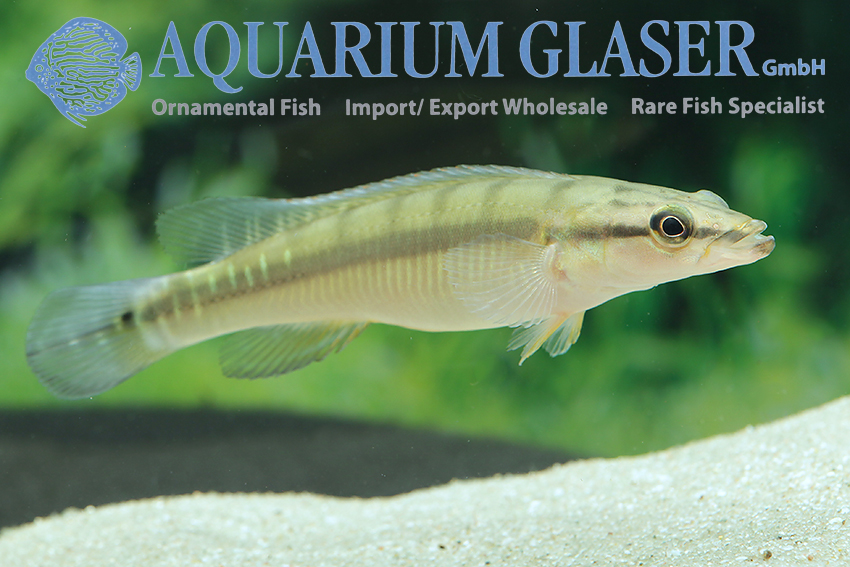
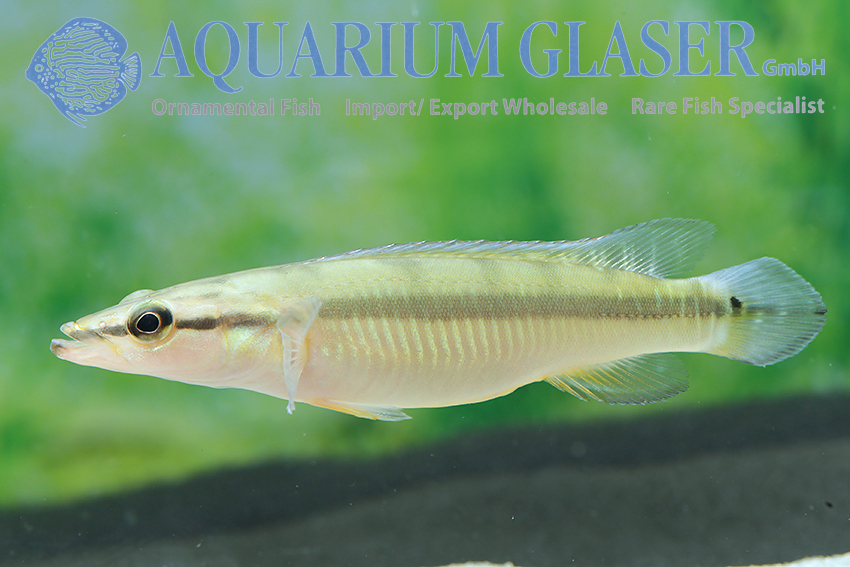
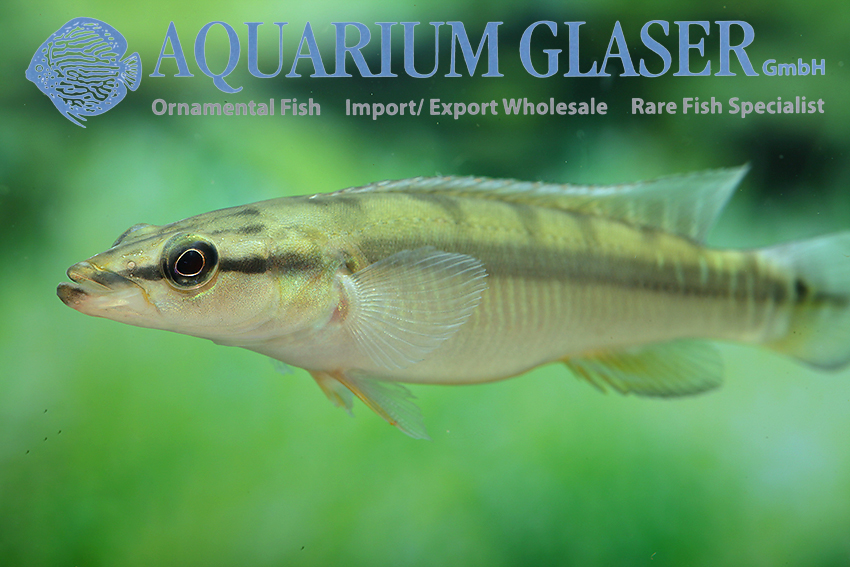
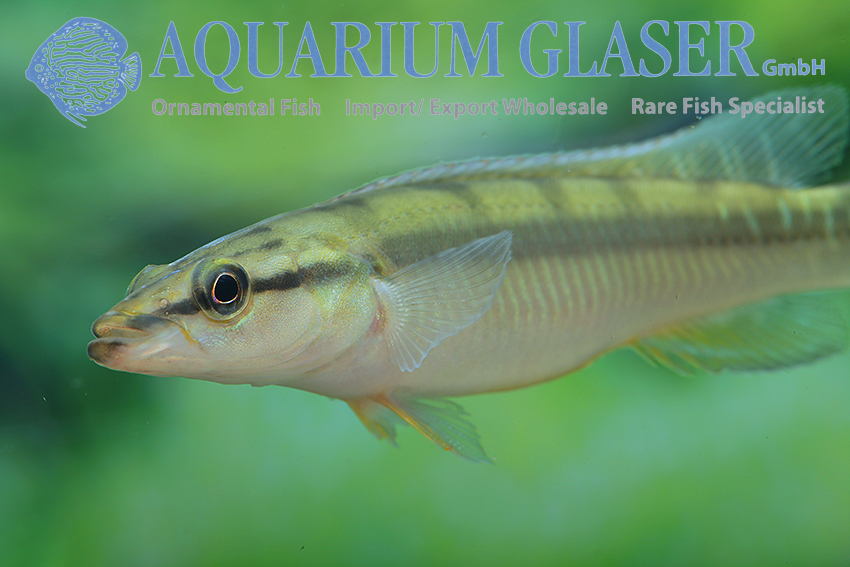
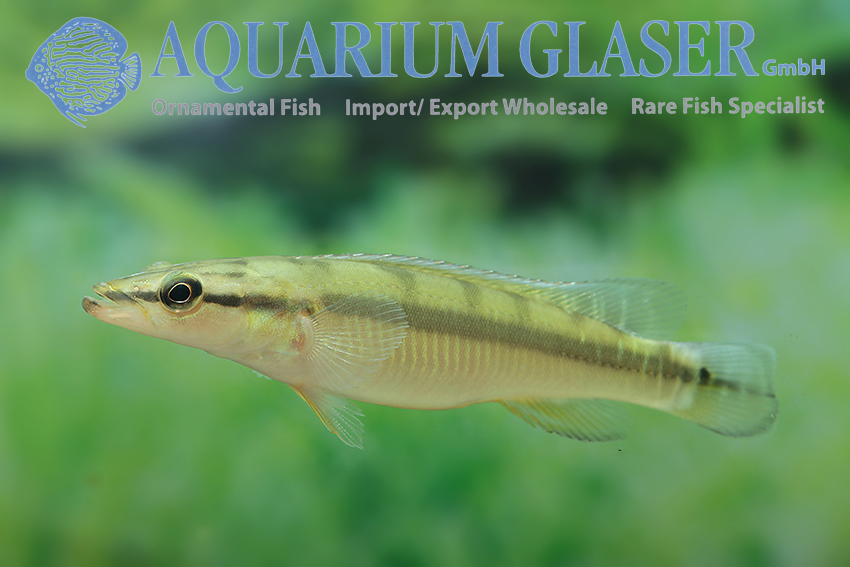
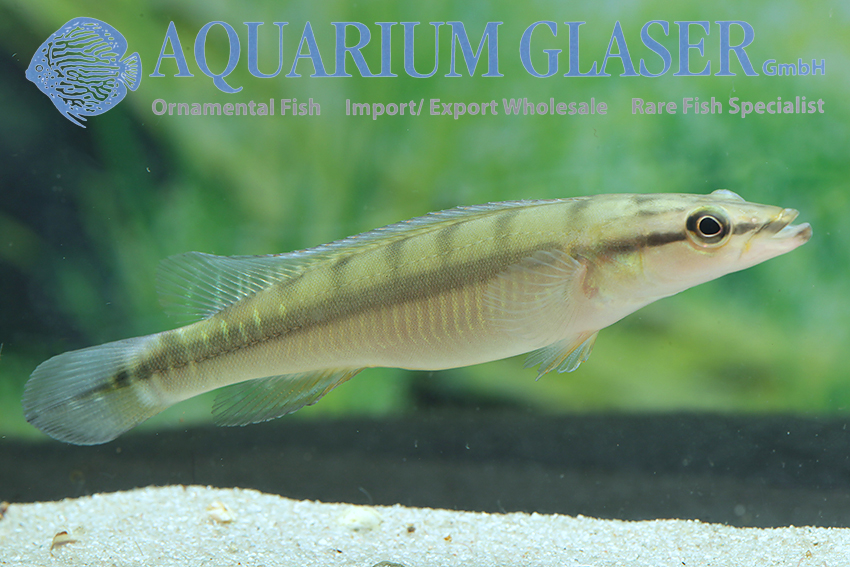
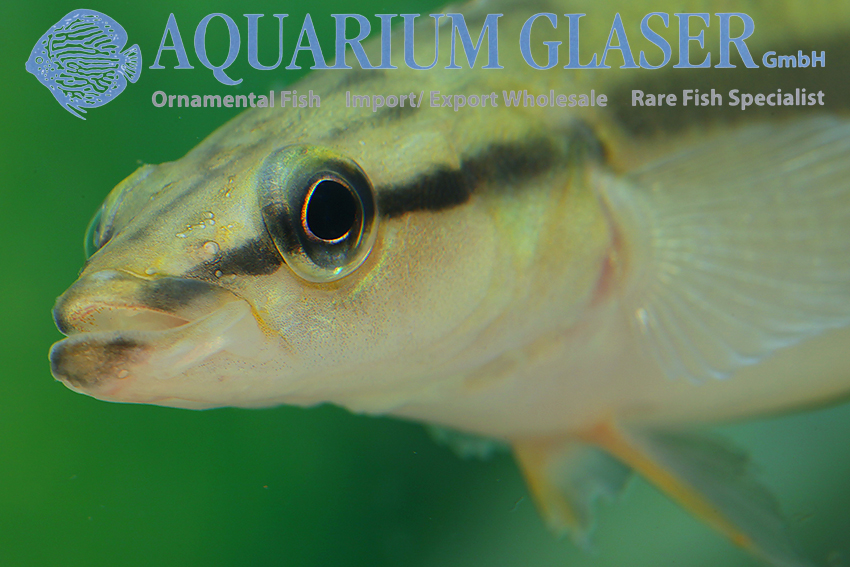
Unfortunately it is hard to tell the sexes of C. zebrina apart and furthermore randomly mated animals rarely get along. Juveniles, on the other hand, are inconspicuous in coloration and still expensive, but quite peaceful among themselves. A troop of young animals is the best chance to get to a breeding pair.
At the moment we can offer once again adult animals (for pictures see https://www.aquariumglaser.de/en/fish-archives/first_import_crenicichla_zebrina_arrived_en/ and https://www.aquariumglaser.de/en/fish-archives/crenicichla_zebrina_en-2/ and also youngsters (actual photos in this post and https://www.aquariumglaser.de/en/fish-archives/crenicichla_zebrina_en/).
For our customers: the animals have code 674051 (5-8 cm) and 674058 (24-28 cm) on our stocklist. Please note that we only supply wholesale.
Text & photos: Frank Schäfer
Rhinogobius shennongensis
The brook gobies (Rhinogobius) are as adult fishes pure freshwater inhabitants, which are found at most once in the brackish water of the lower reaches of running waters; but even this is the exception, not the rule. With 140 described species, 72 of which are generally considered valid, there is still a wide open field here for aquarists with an urge to explore. All species can be maintained well in the aquarium. When breeding, there are those Rhinogobius that have tiny larvae that grow in the sea and those that have large larvae that grow in freshwater. All species are cave spawners, the male guards the clutch until the larvae hatch. Brood care ends when the larvae swim free.
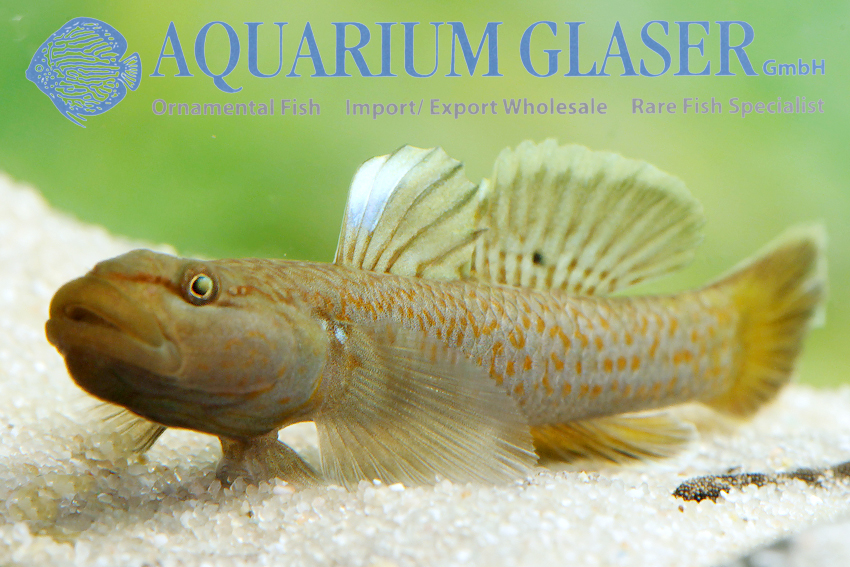
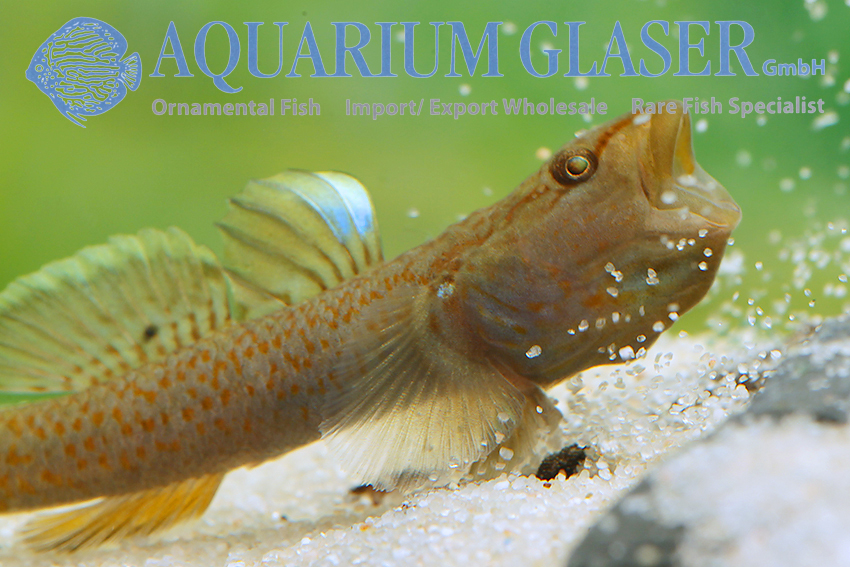
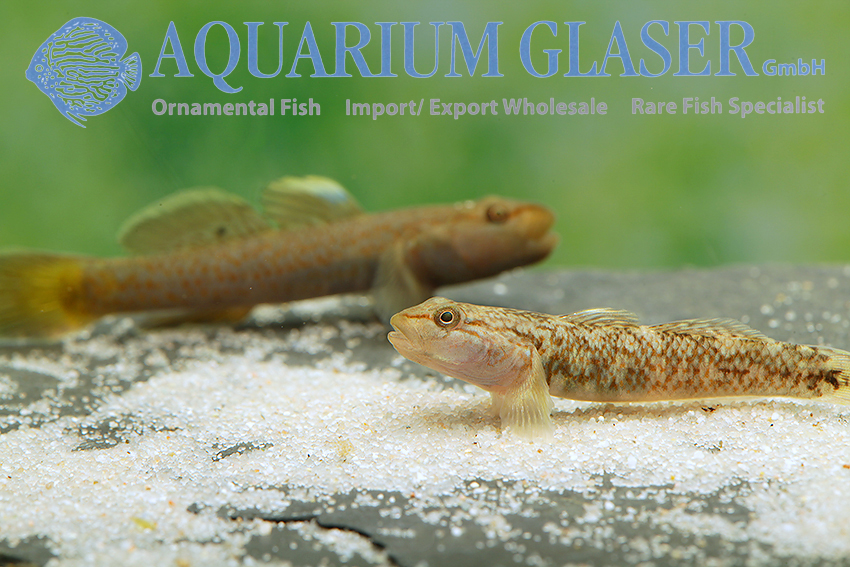
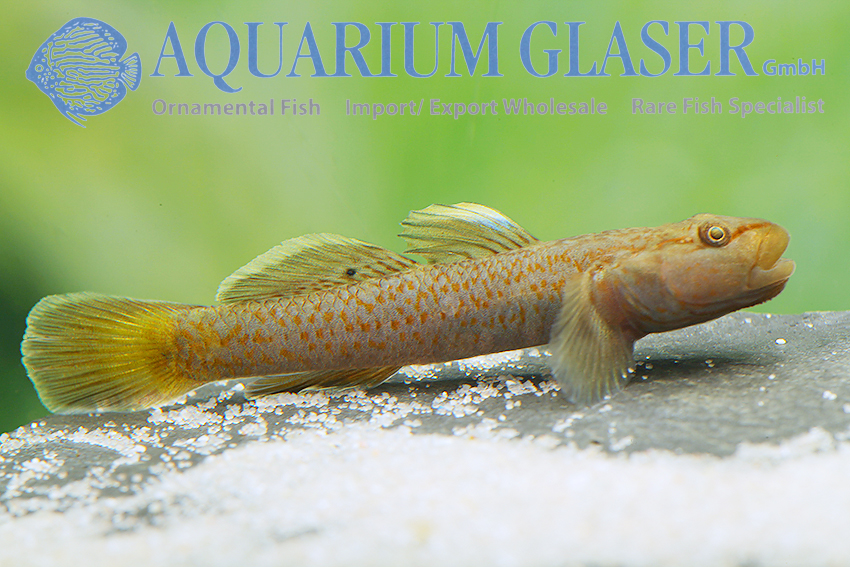
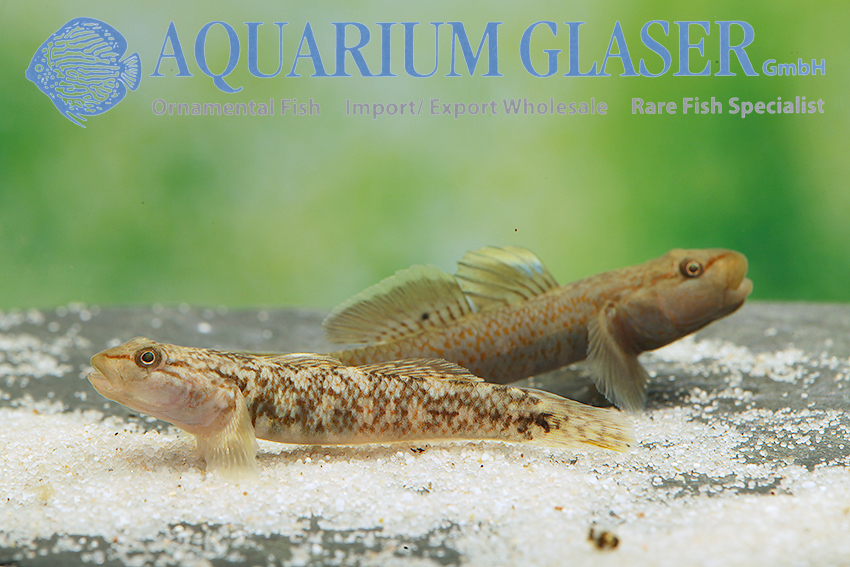
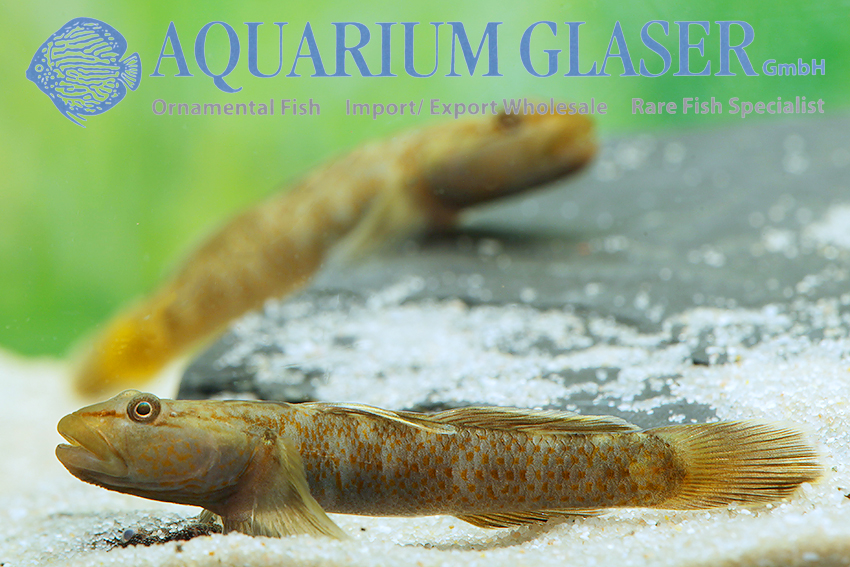
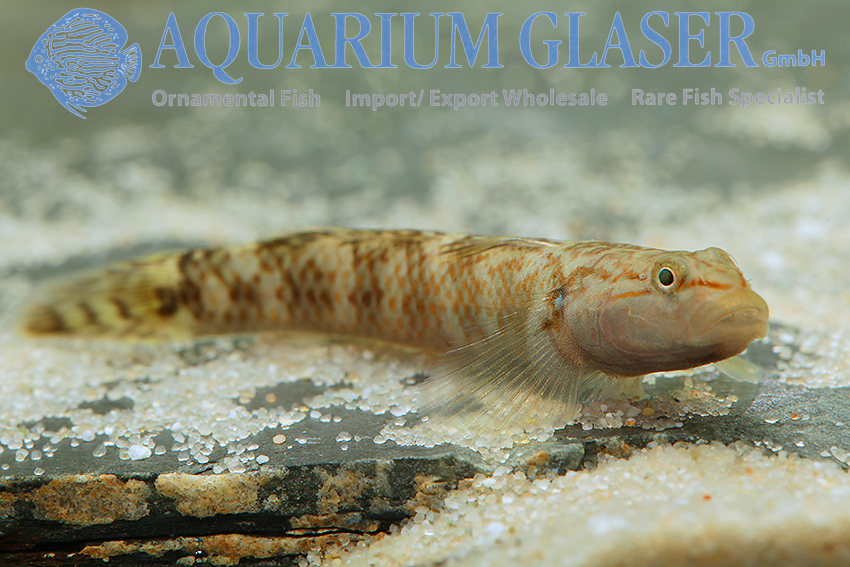
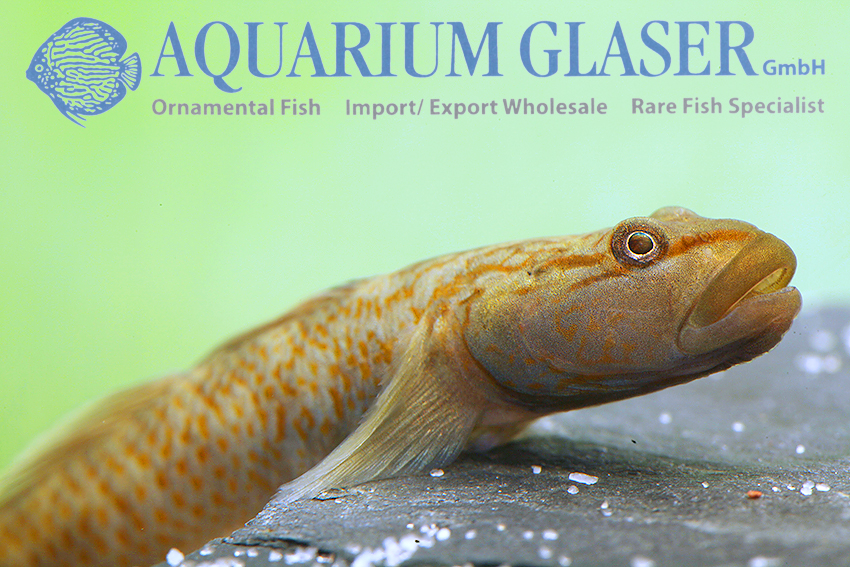
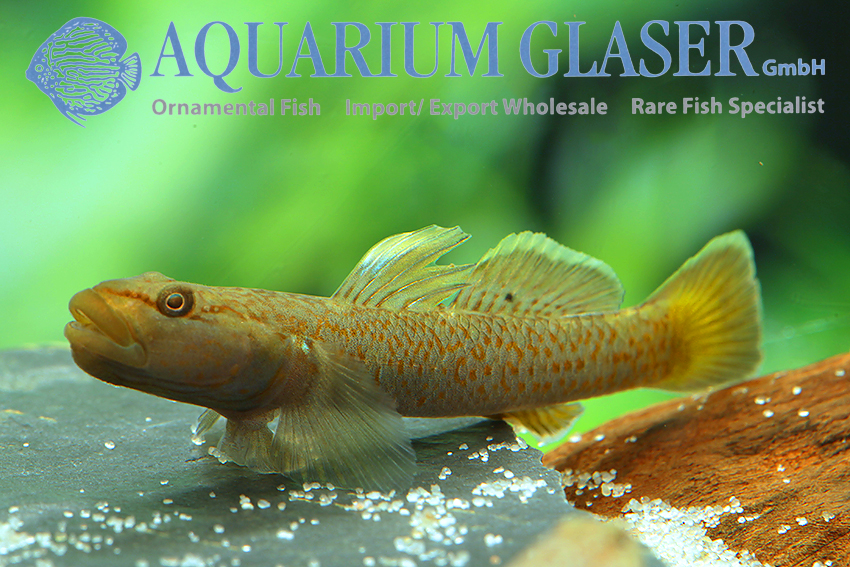
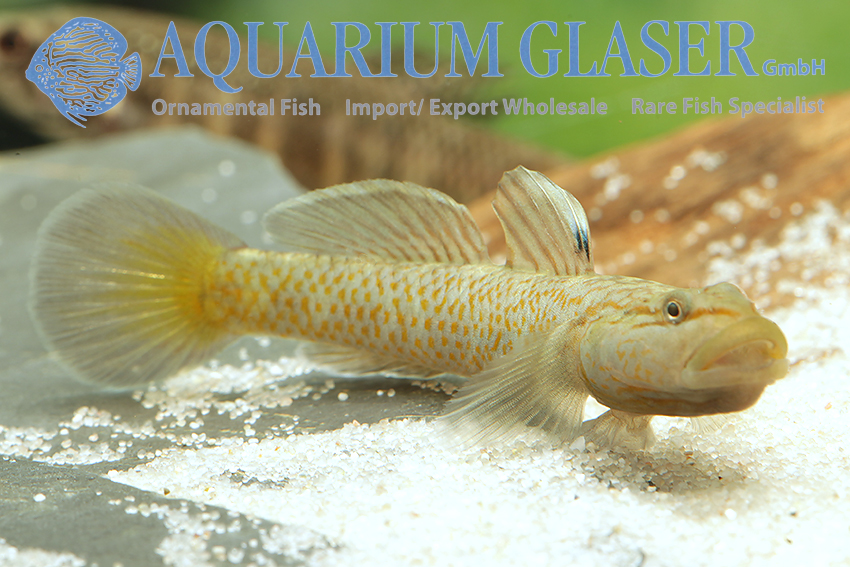
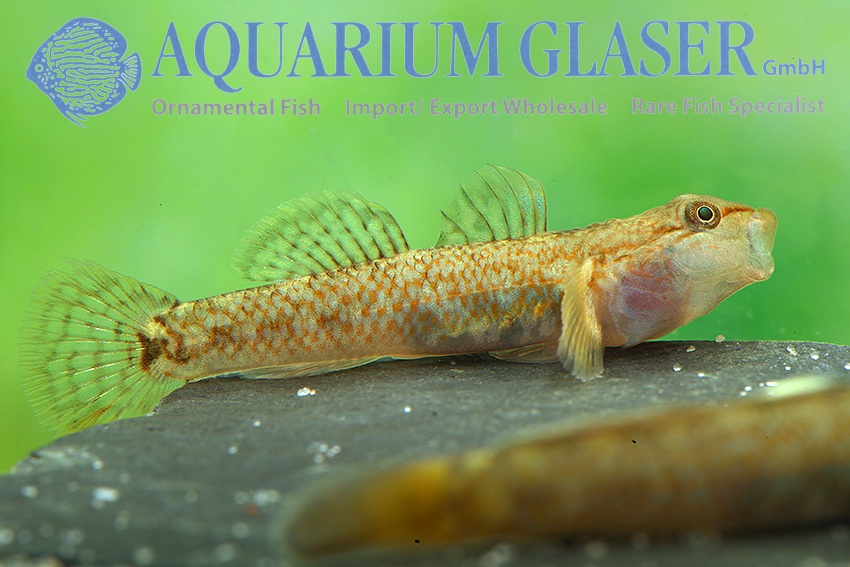
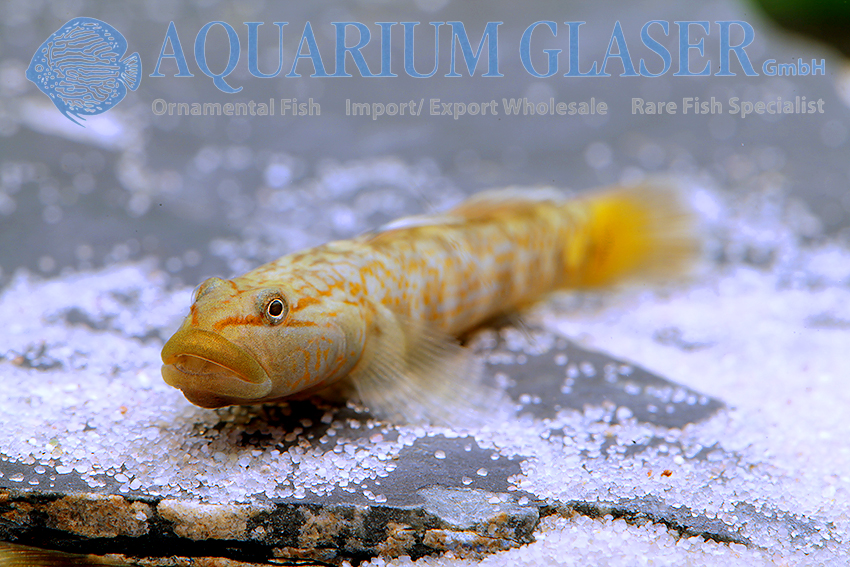
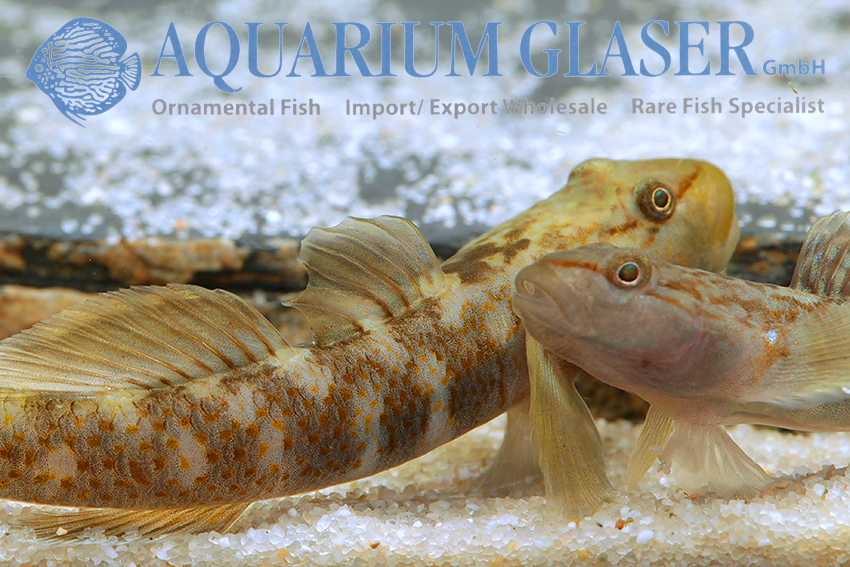
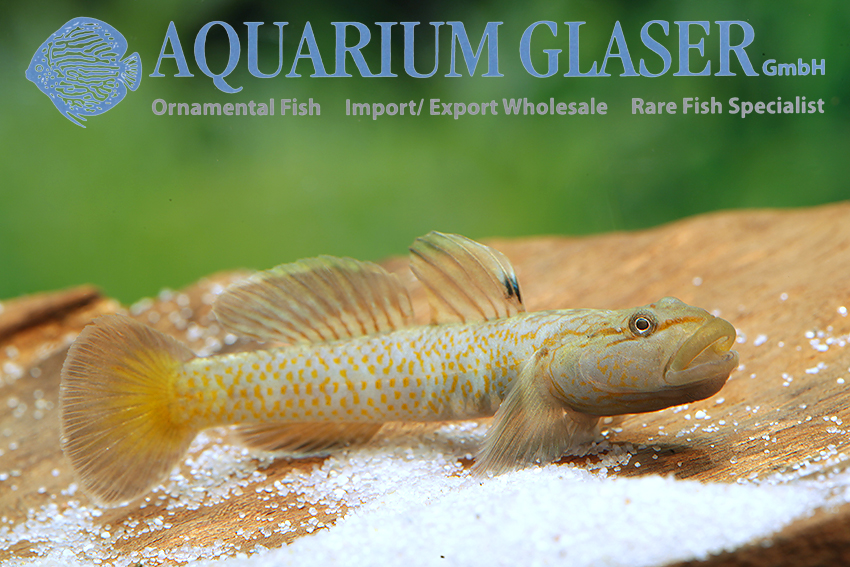
For the first time we could import Rhinogobius shennongensis from China. It originates from the Yangriwan, upper Hanjiang River, Mount Shennnong, Hubei Province. The maximum length is about 5-6 cm, males are larger than females. The sexes are most easily distinguished by the shape of the head. According to their origin, the fish are kept not too warm (18-24°C), in clear, oxygen-rich water with a good current. They are bottom fish, the males form territories. Rhinogobius shennongensis is somewhat quarrelsome; therefore possible tank mates should not be too squeamish. All common ornamental fish food is eaten, although some specimens do not like dry food. Frozen food is always accepted.
For our customers: the fish have code 453480 on our stocklist. Please note that we only supply wholesale.
Text & photos: Frank Schäfer
Scalare leopoldi Red Spots Peru
From Peru we received wonderful, large angels (Pterophyllum). They have a yellowish to reddish back and many brown-red spots on the flanks. This exceptionally beautiful wild form has been called Pterophyllum leopoldi for decades due to a misidentification in aquarium circles. The “true” P. leopoldi originates from Brazil and is the fish always referred to in the hobby as P. dumerilii, while the “true” P. dumerilii from Brazil is considered synonymous with P. scalare. Other names, equally incorrect, that circulate for Peru scalars are “Peru Altum” or “Pterophyllum peruensis”.
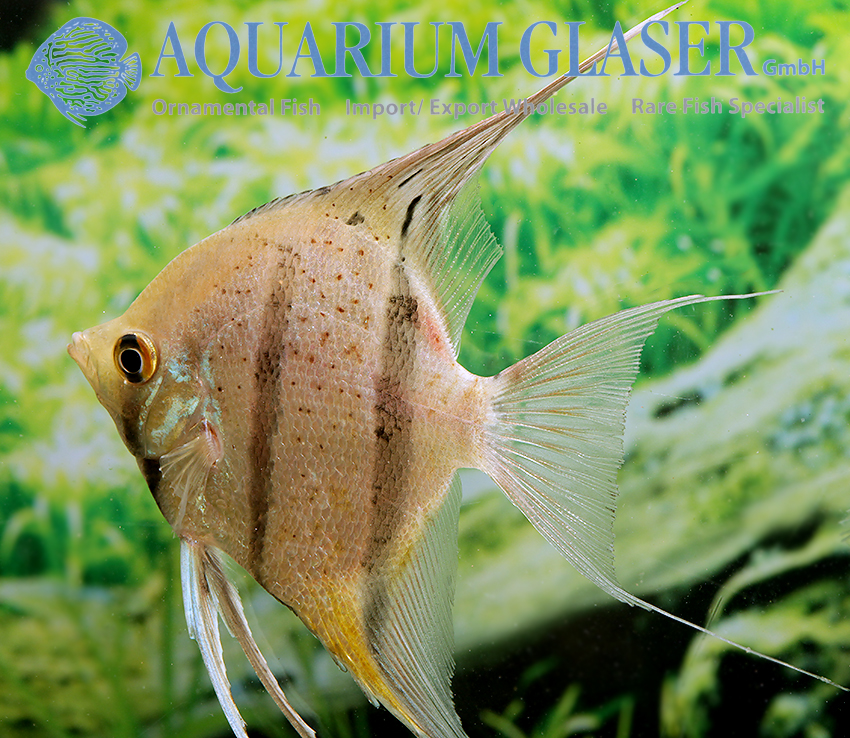
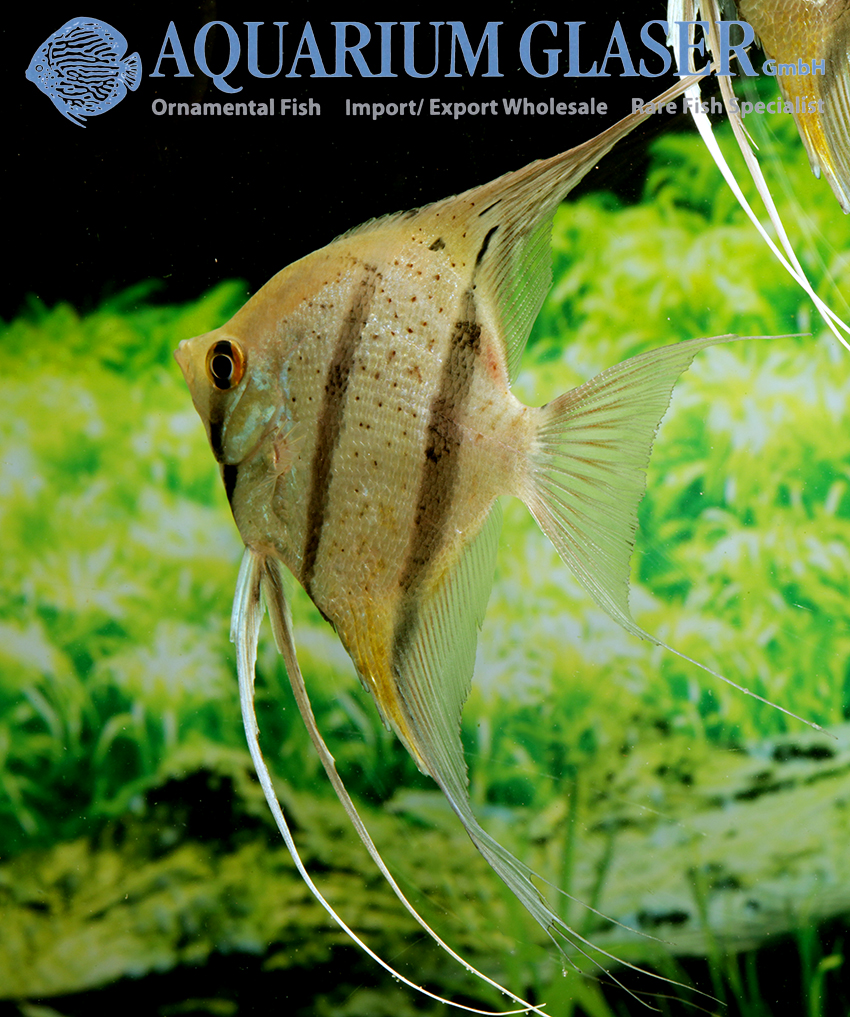
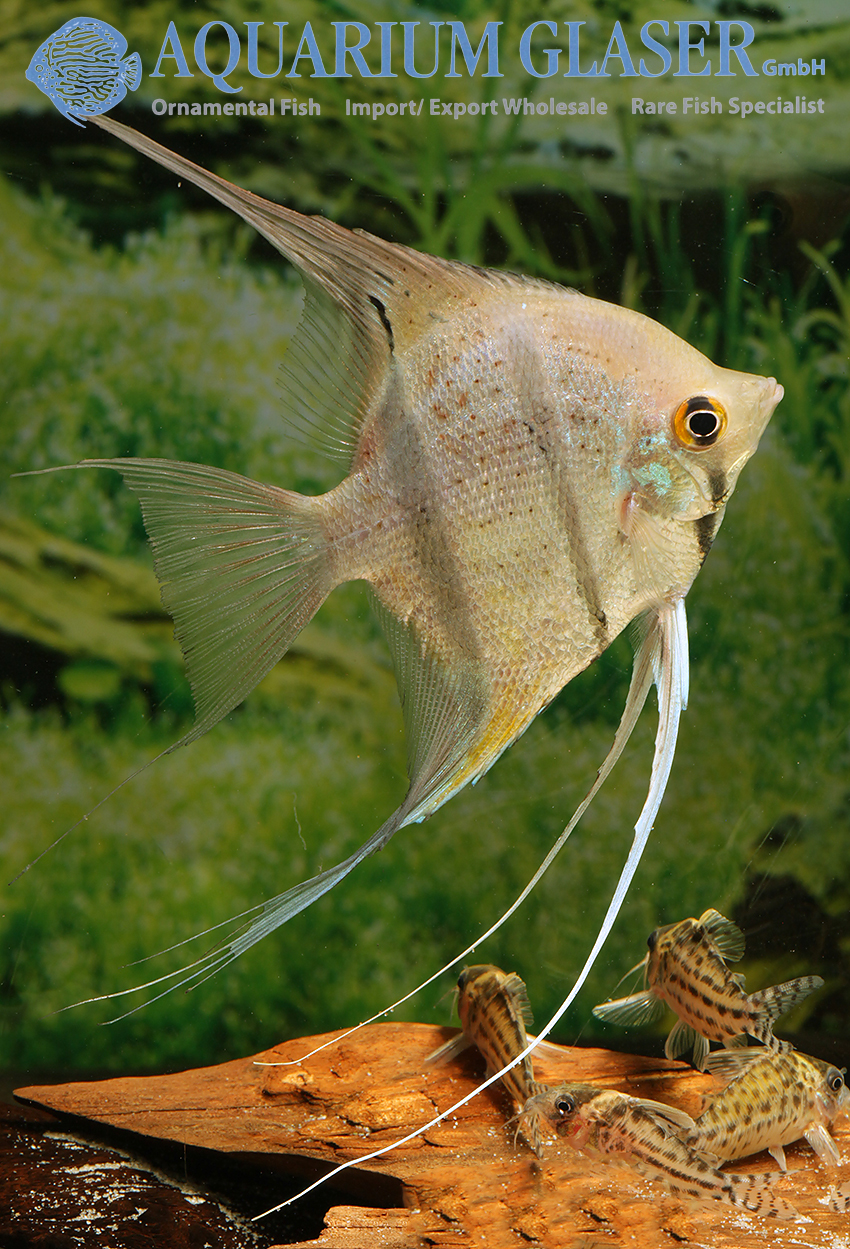
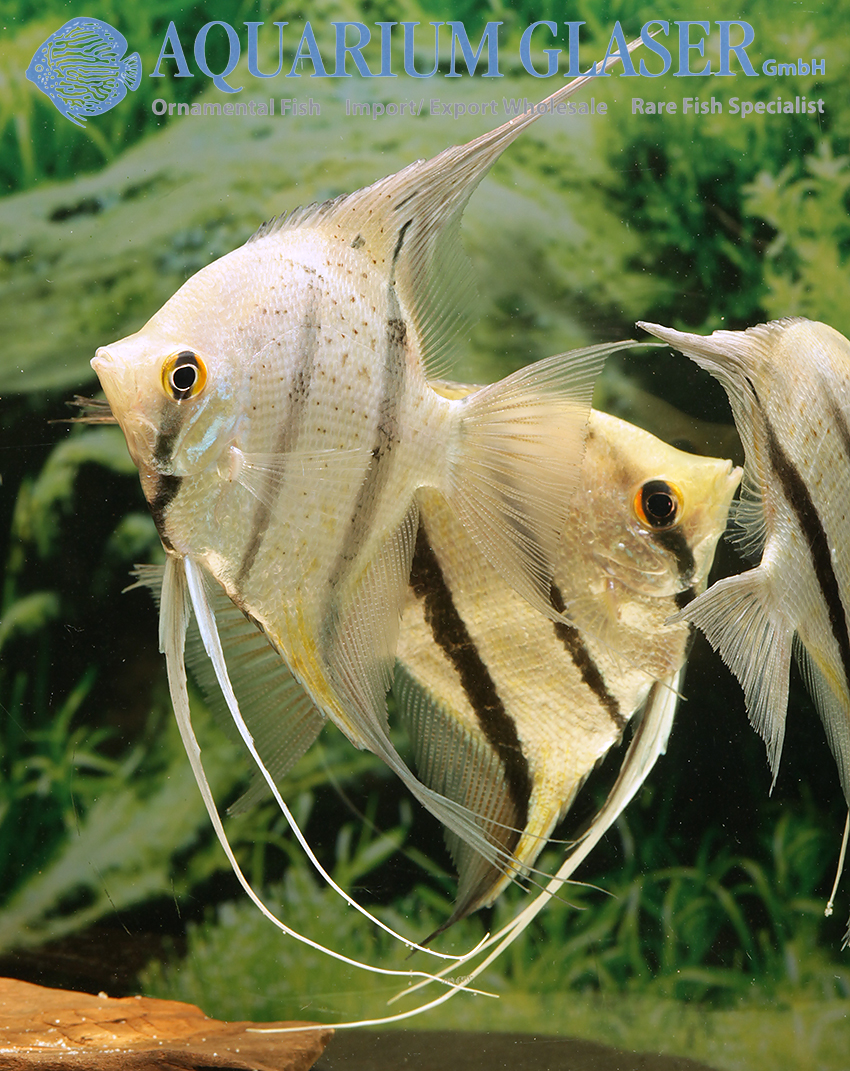
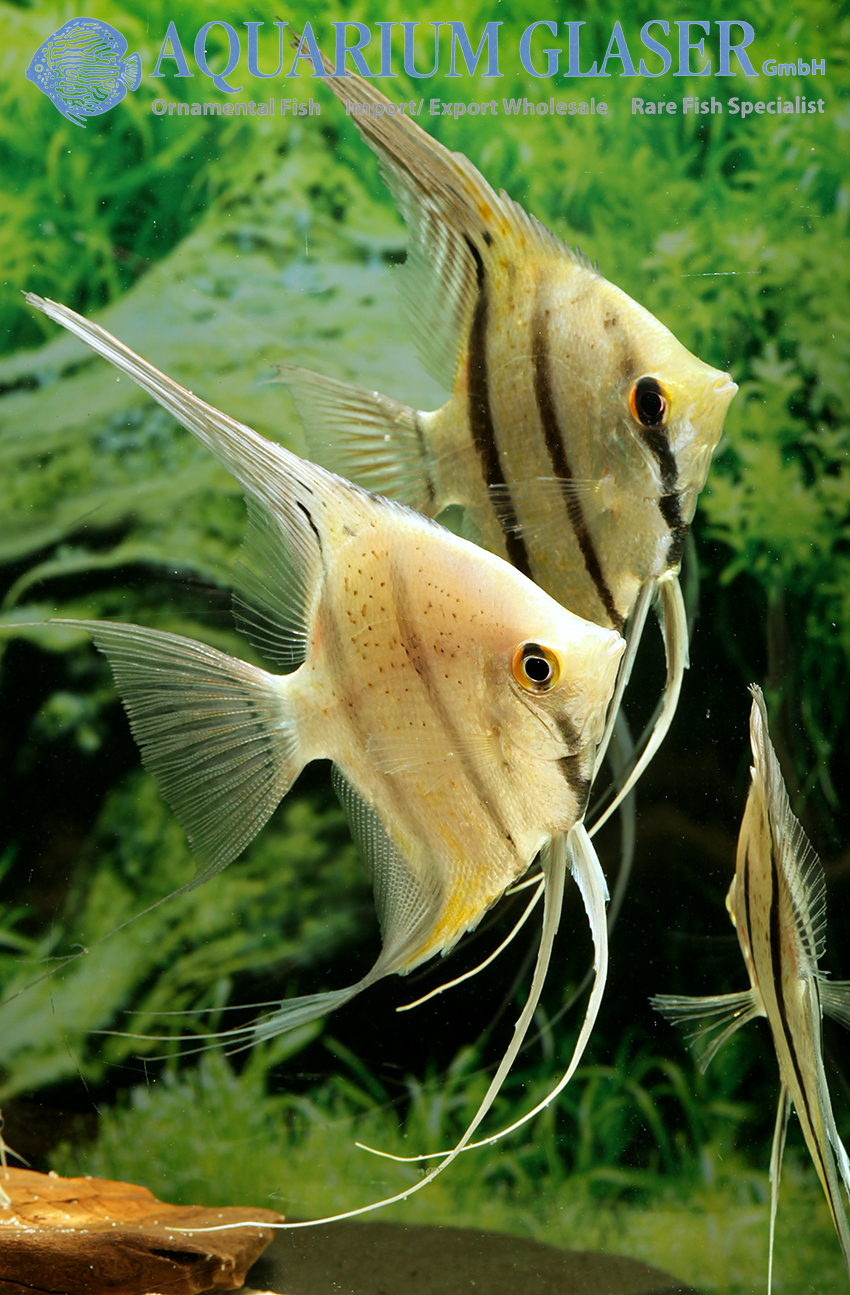
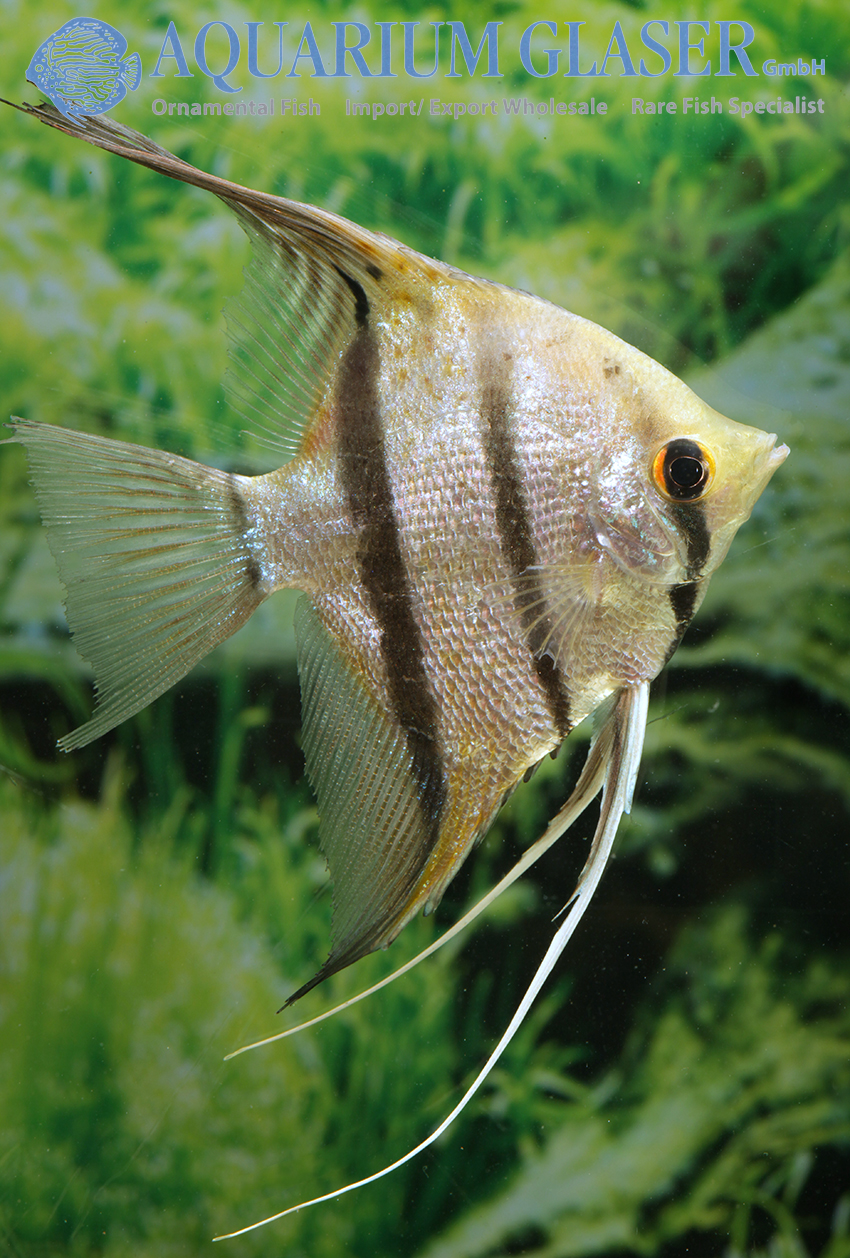
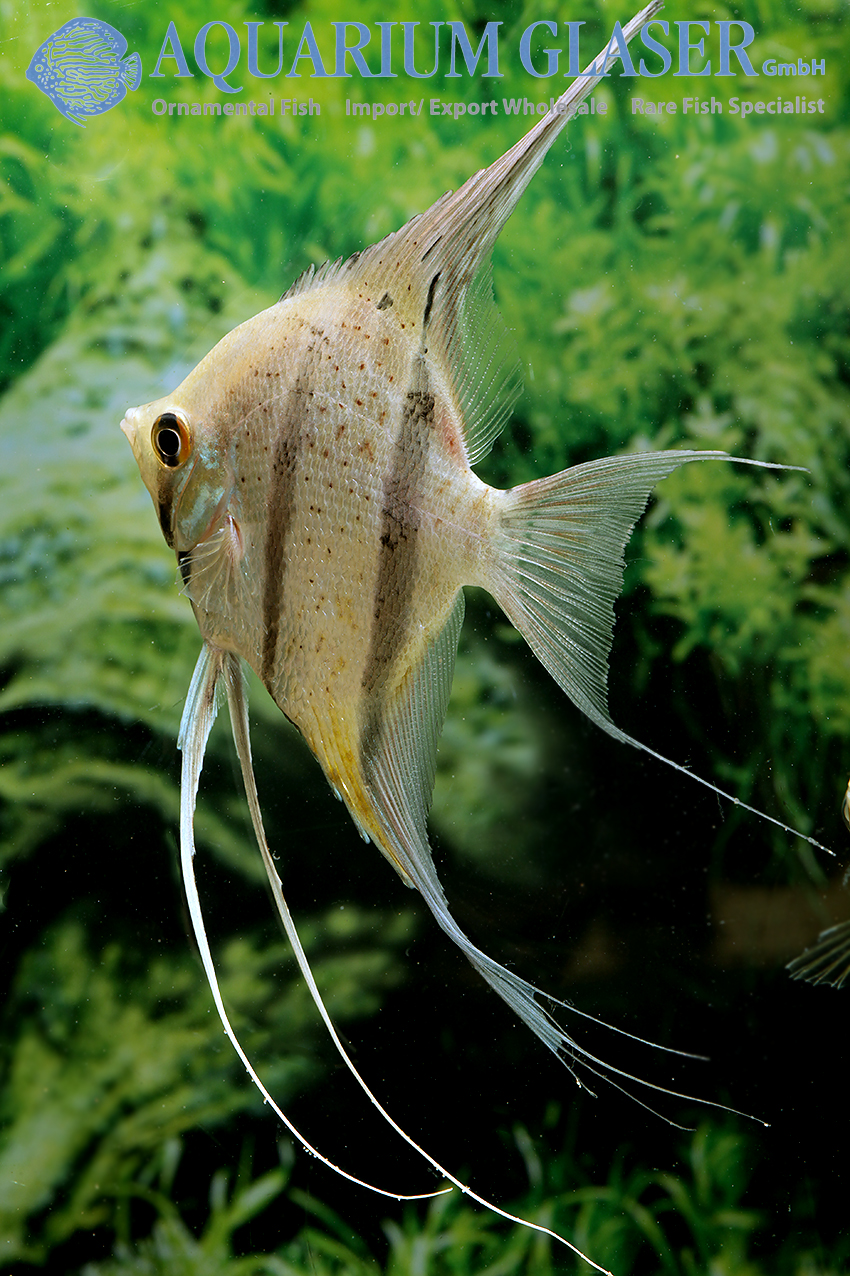
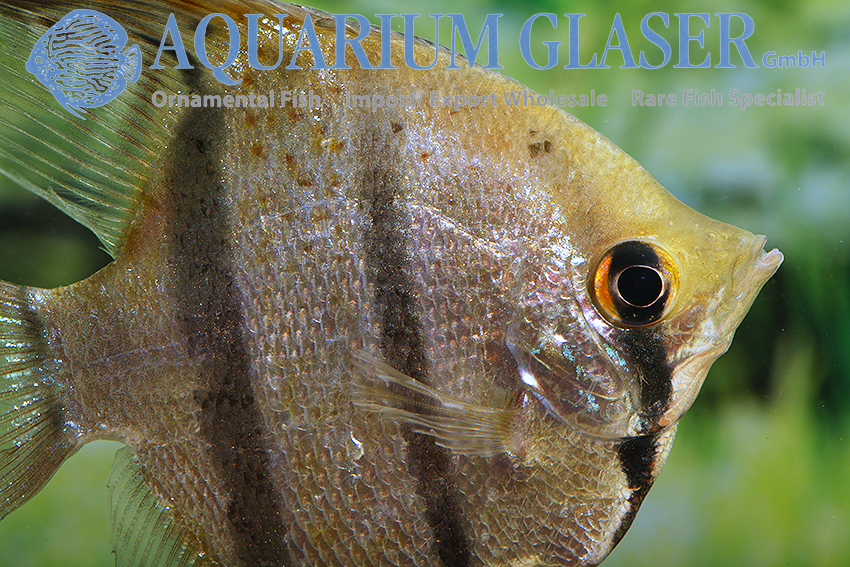
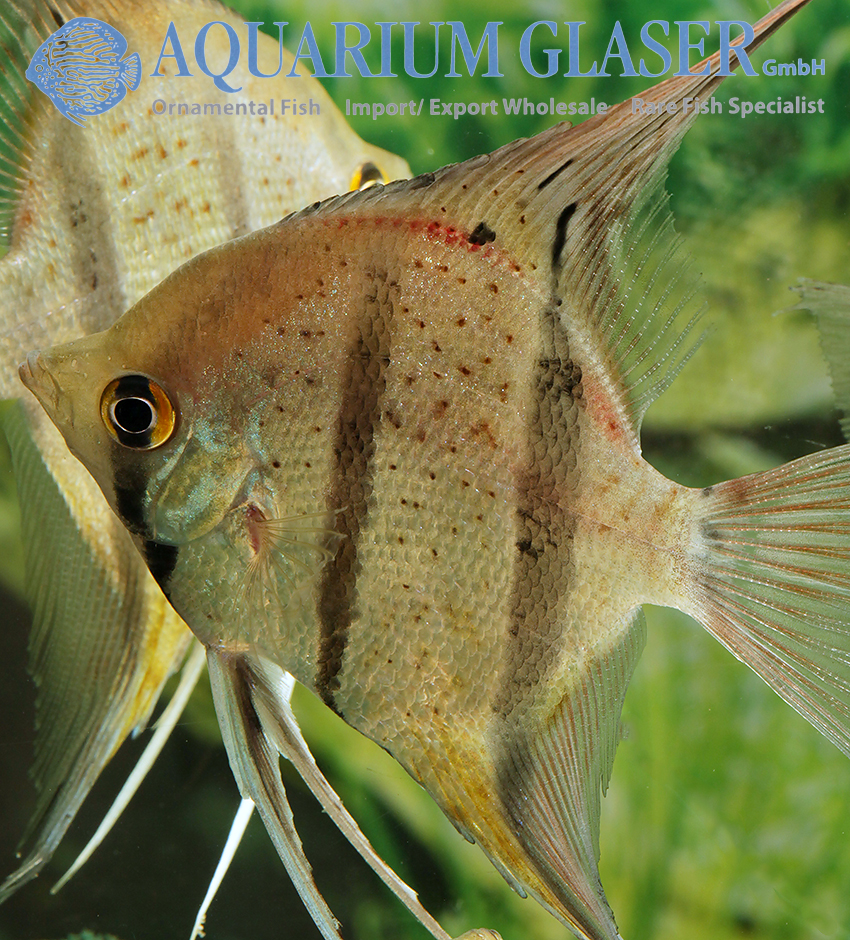
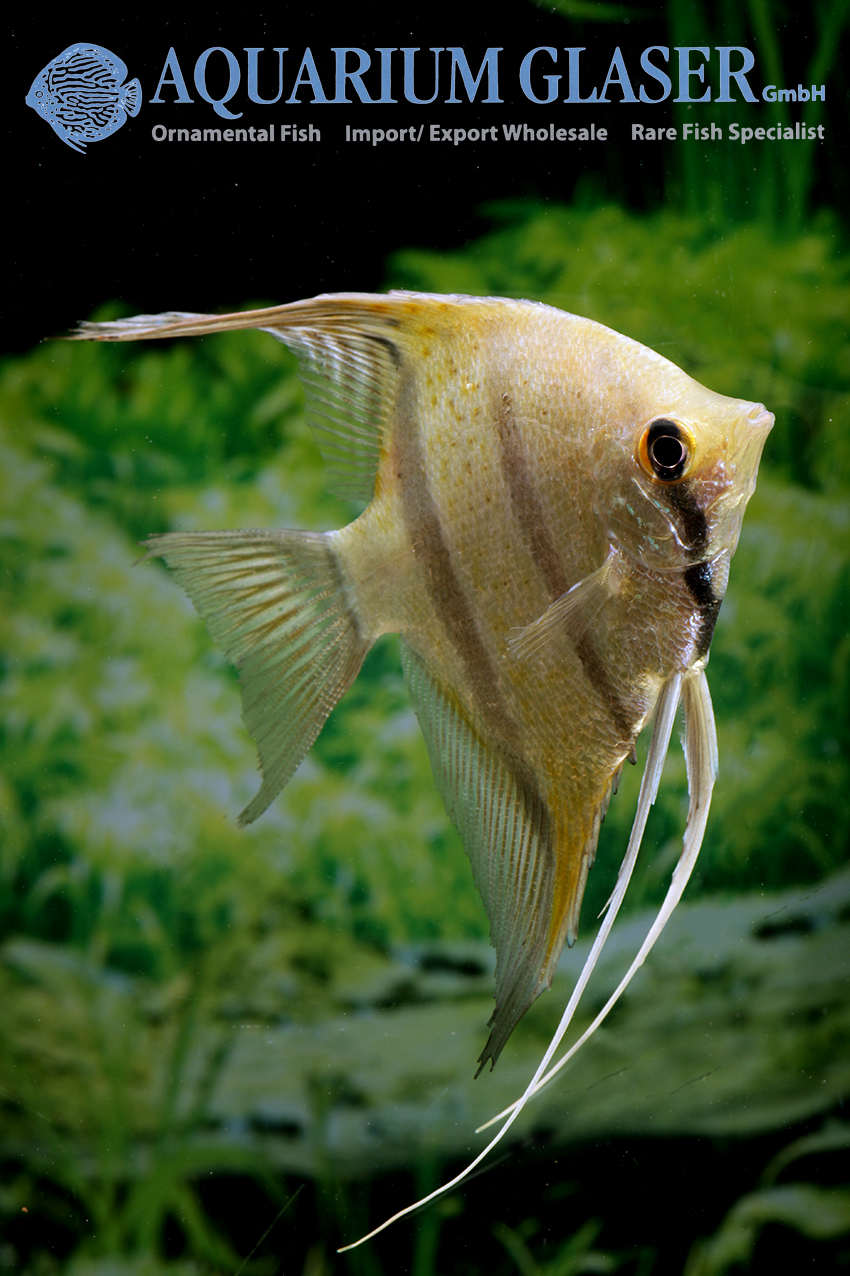
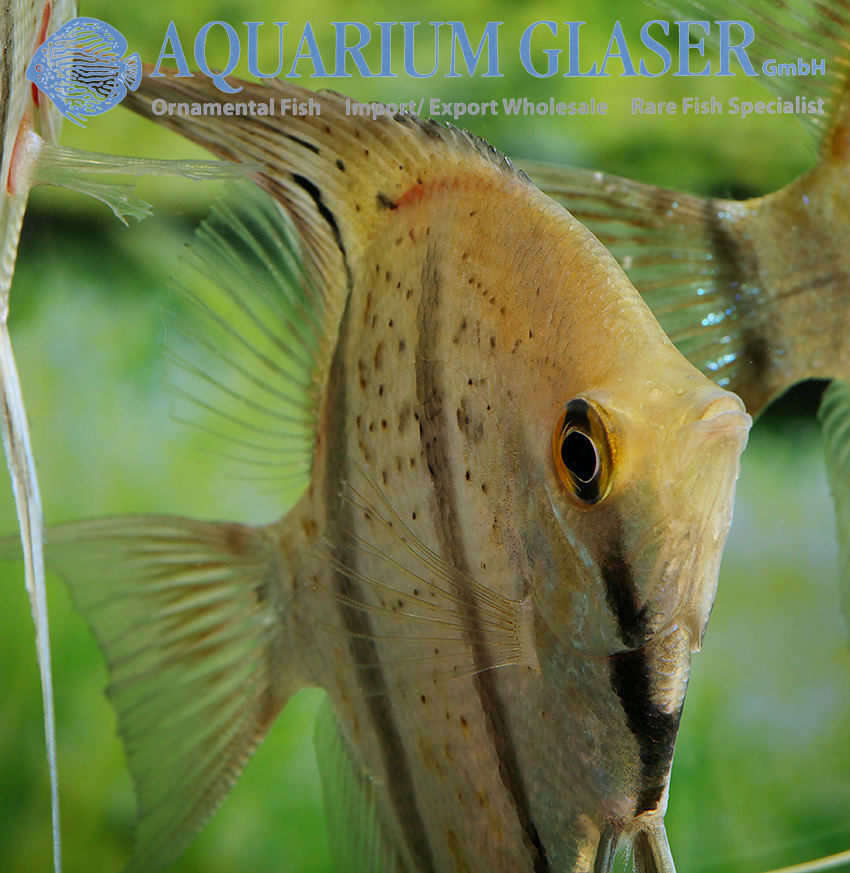
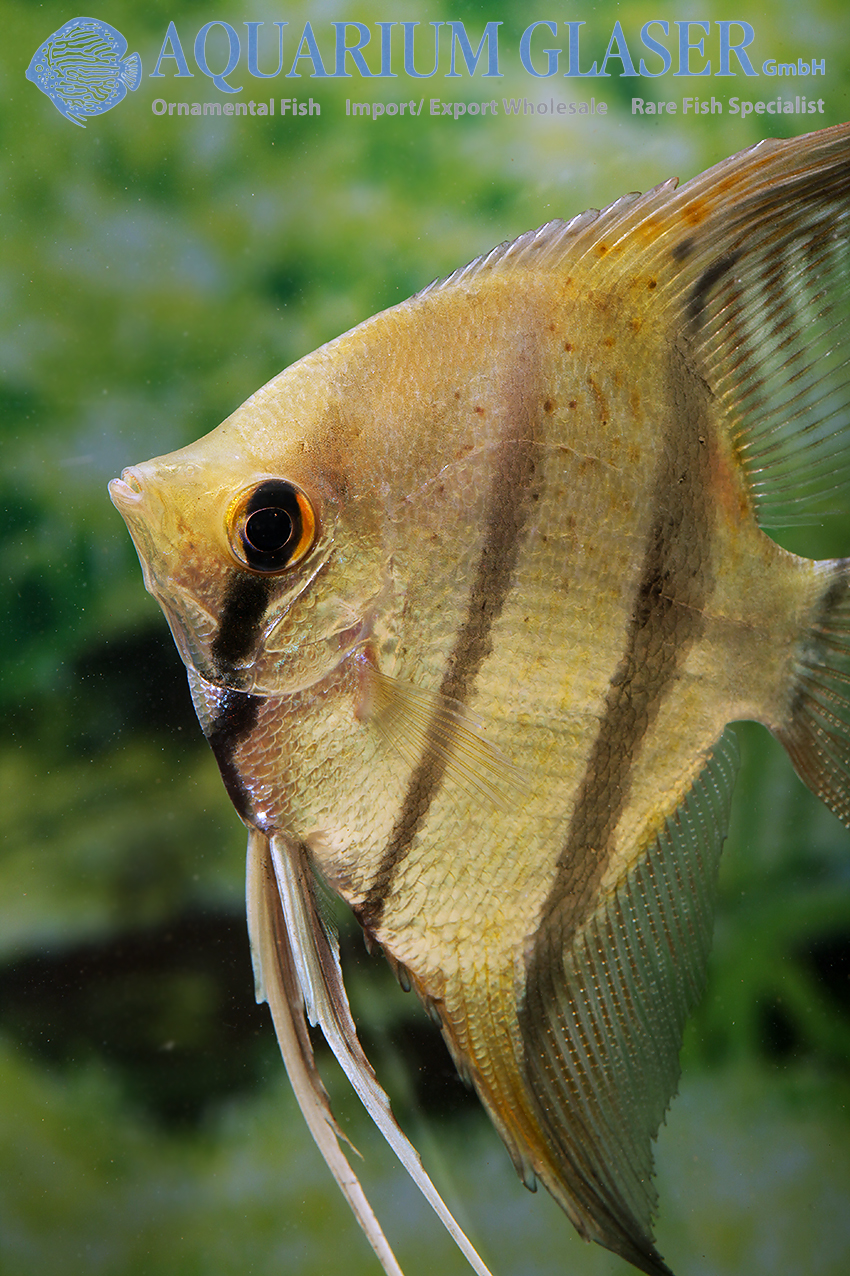
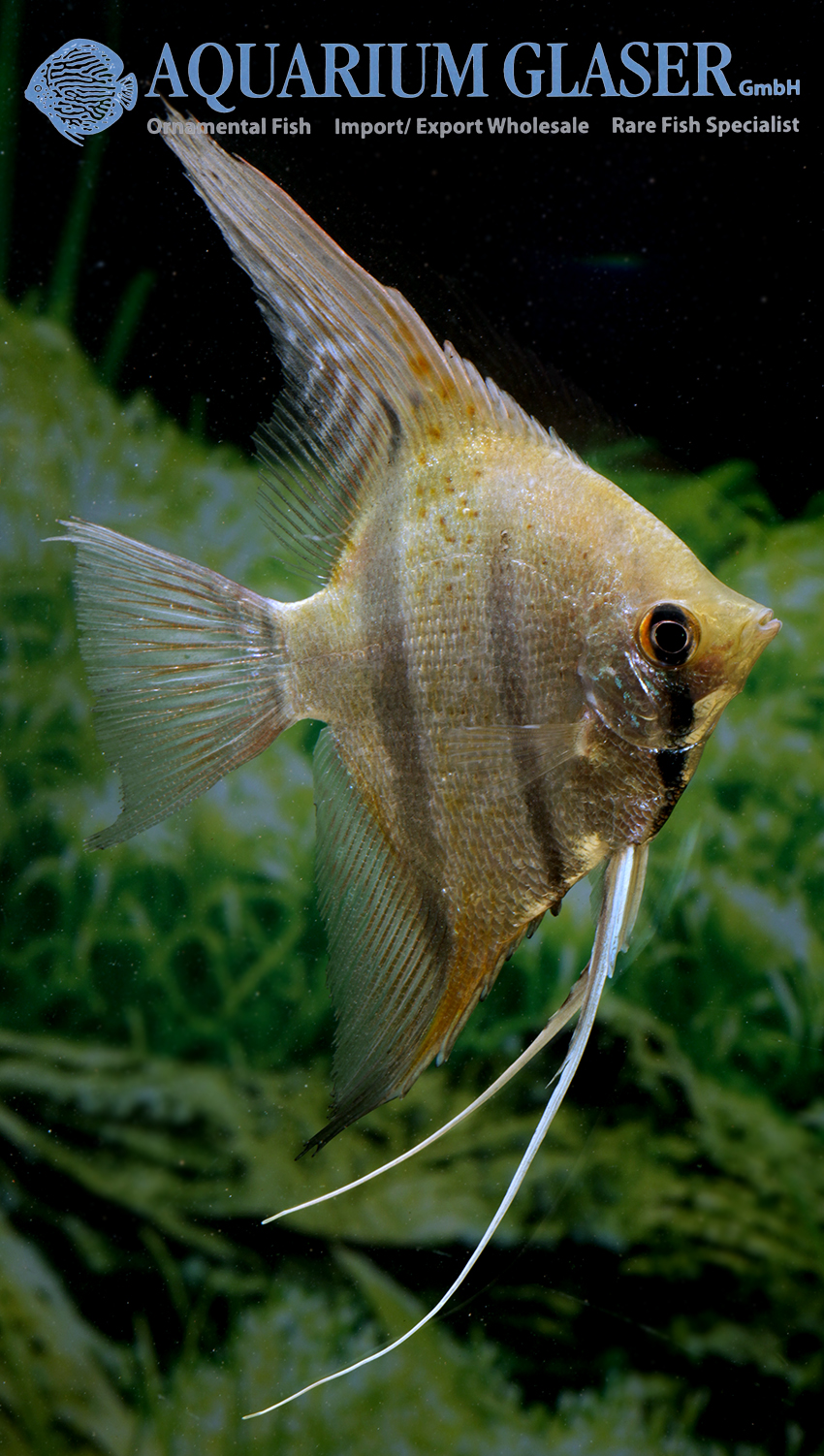
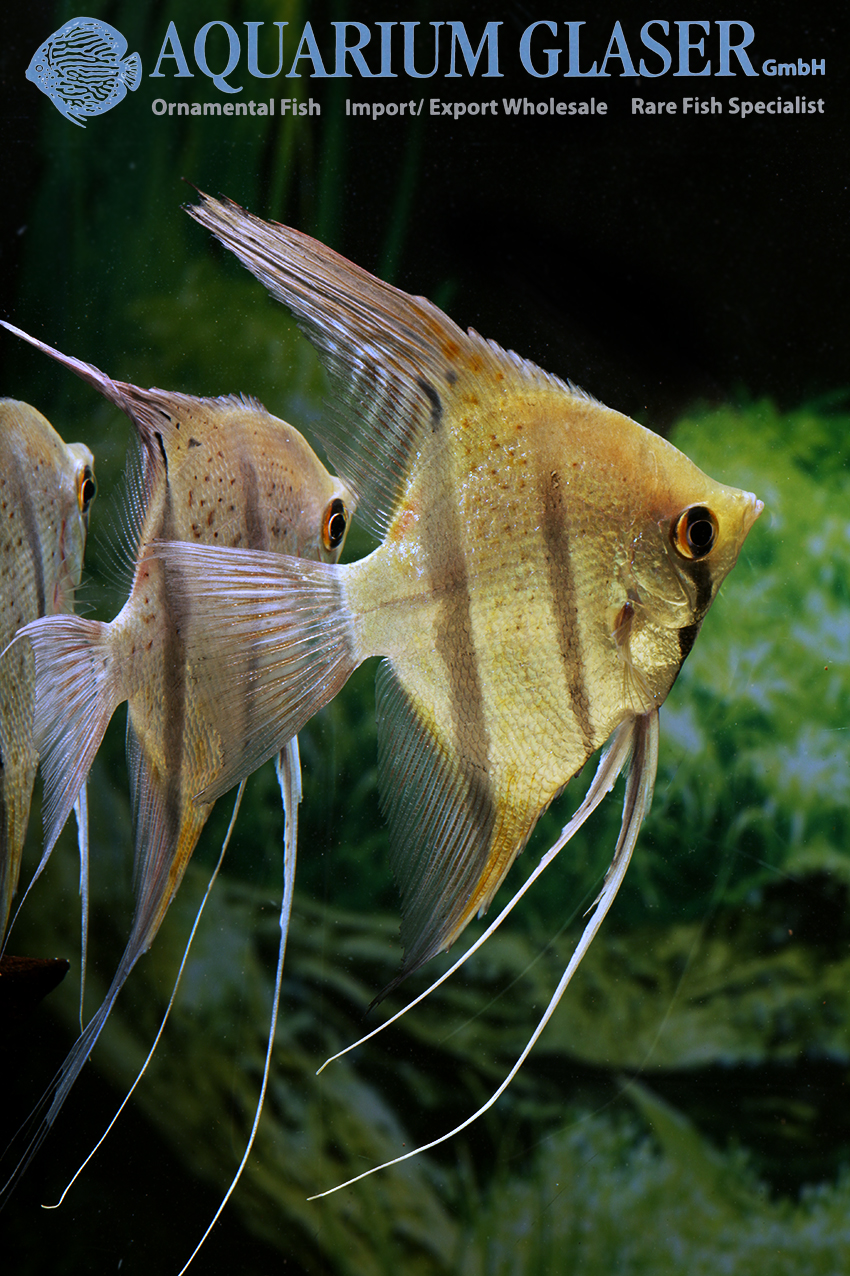
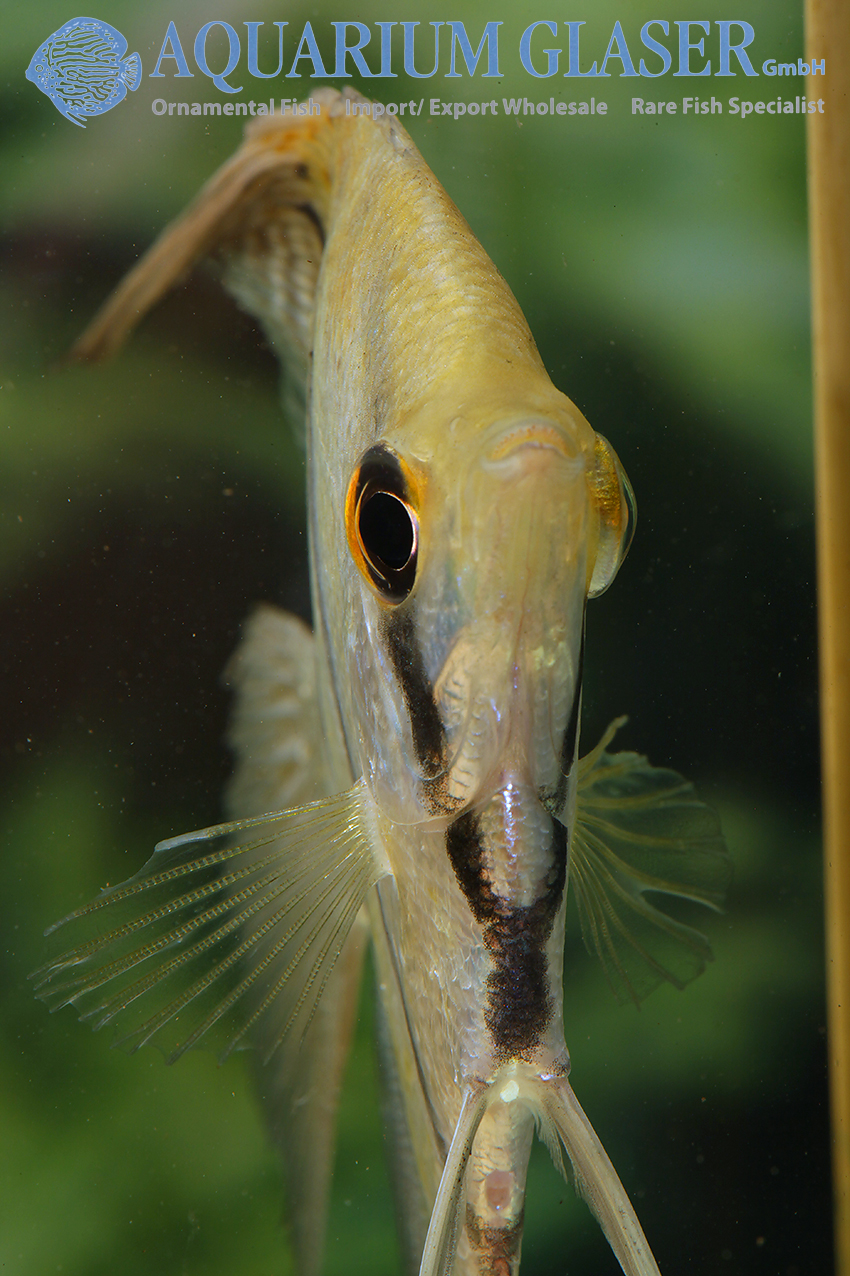
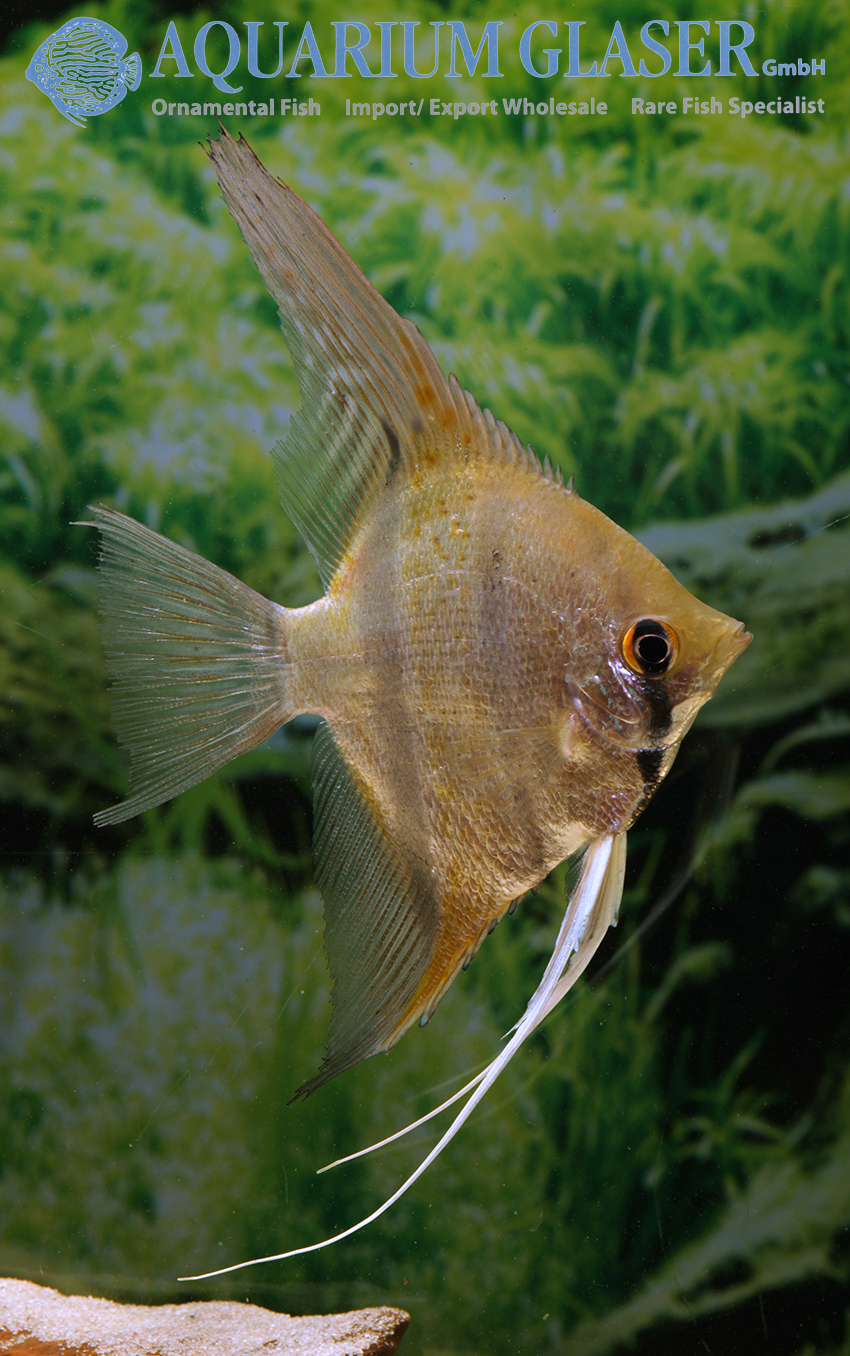
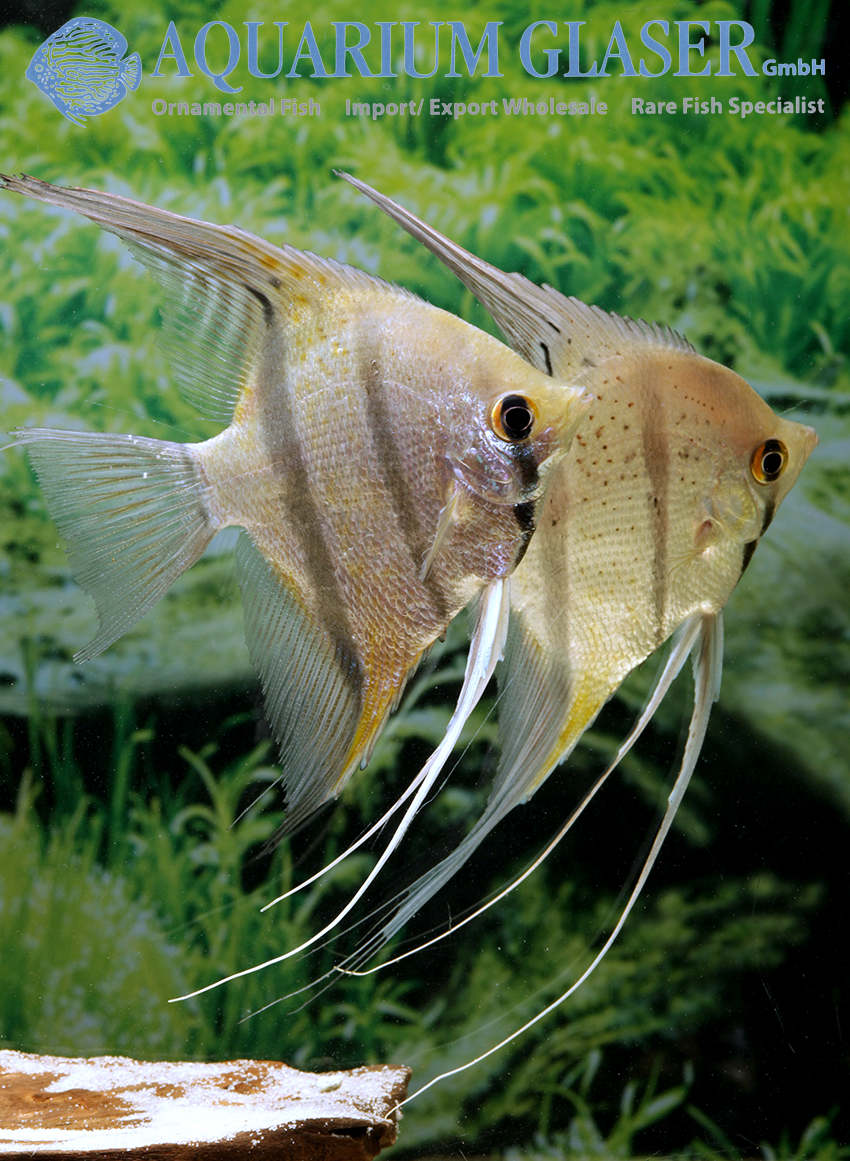
In fact, the “Red Spots Peru” is a scientifically undescribed species. This has nothing to do with the red spots: this species also exists without red spots. Rather it is the black, comma-shaped spot, which extends as extension of the 2nd body bandage into the dorsal fin, which is characteristic for the species (in the order: eye bandage – 1st body bandage – 2nd body bandage – tail root bandage, thus four dark vertical bands, of which the tail root bandage is often only indistinctly visible).
Regardless of the name, the red-spotted angelfish from Peru are magnificent animals, which unfortunately can be imported only very rarely and in small numbers.
For our customers: the animals have code 699307 on our stocklist. Please note that we only supply wholesale. Only available in limited numbers!
Text & photos: Frank Schäfer
Geophagus steindachneri
The redhump eartheater (Geophagus steindachneri) from Colombia has had a regular place in the aquarium since it was first imported to Germany in 1972. There are numerous reasons for this. First of all it is very attractively colored. The males develop a red colored forehead hump, which varies very much in size. Over all: the size. In fact, G. steindachneri can grow up to 25 cm long! But sexual maturity starts already with 6 -7 cm length.
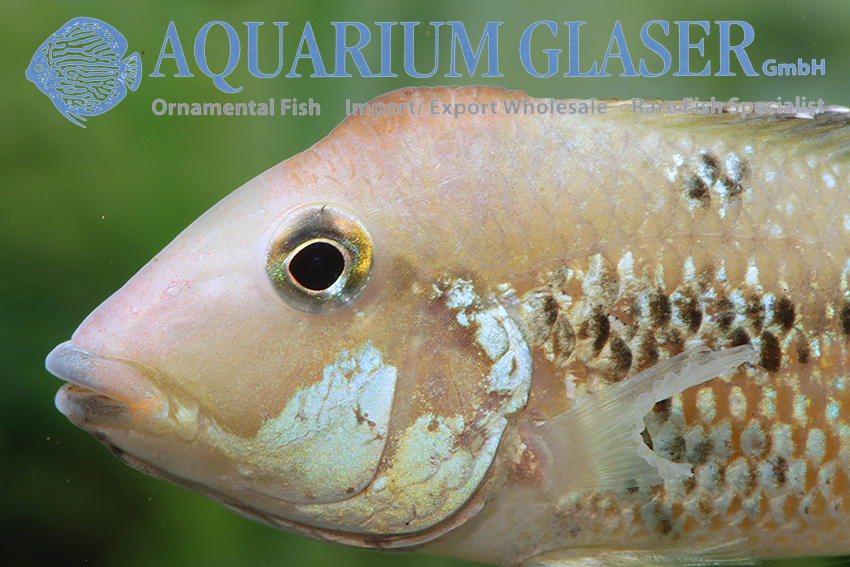
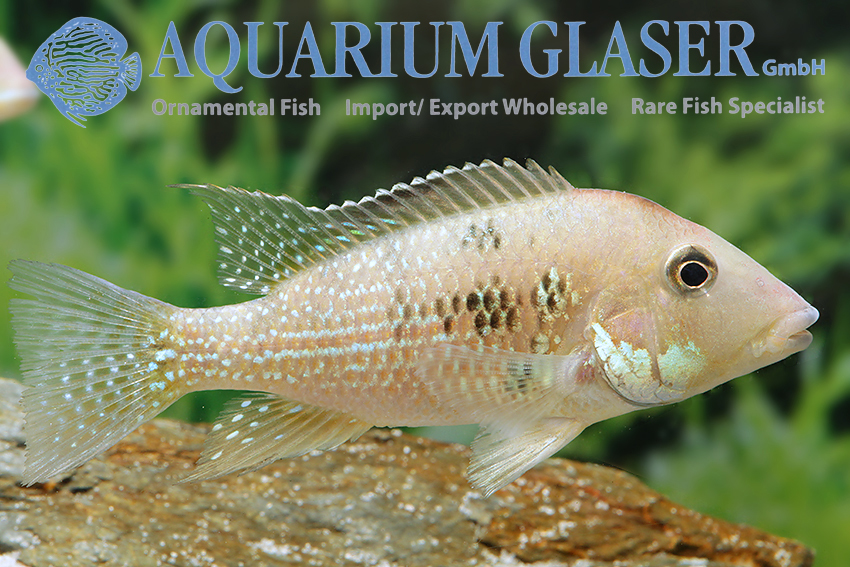
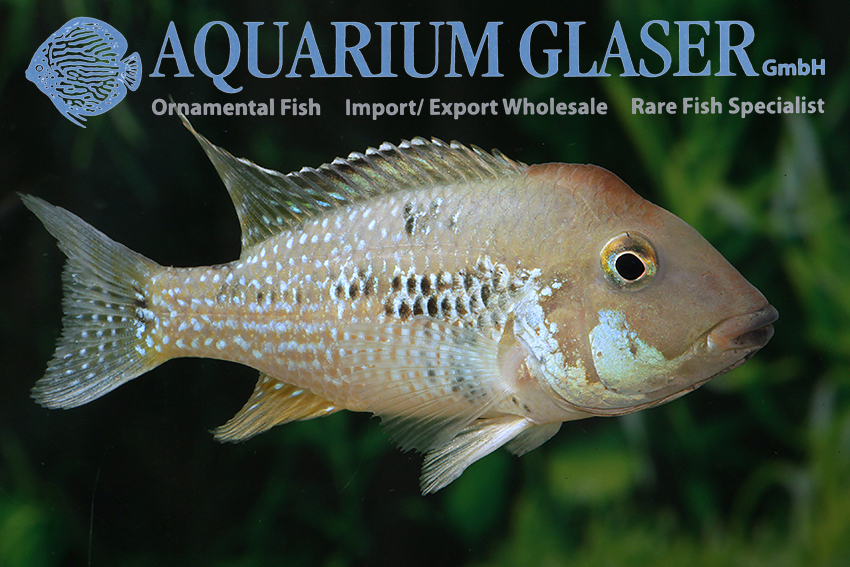
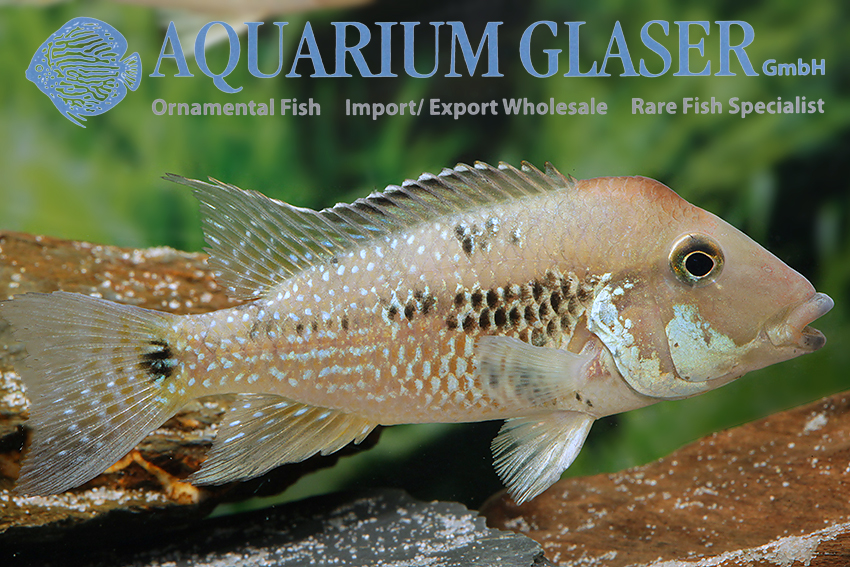
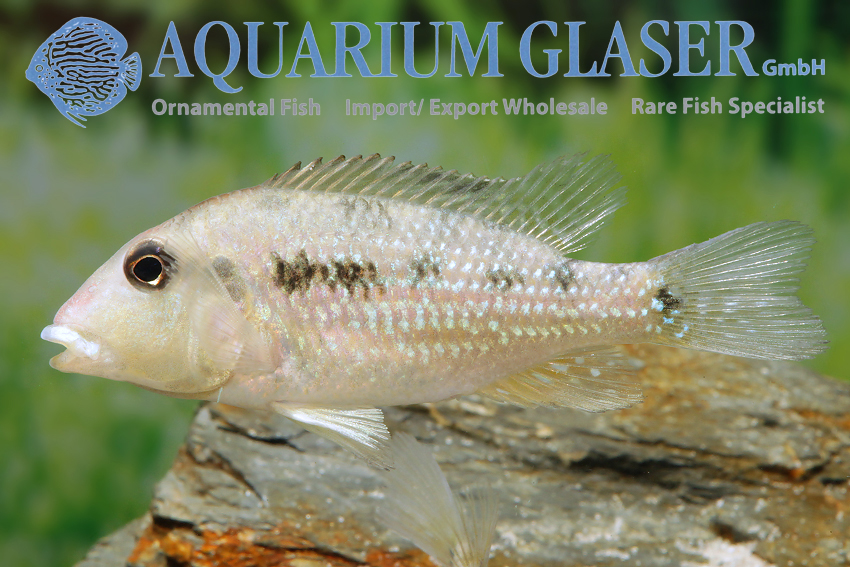
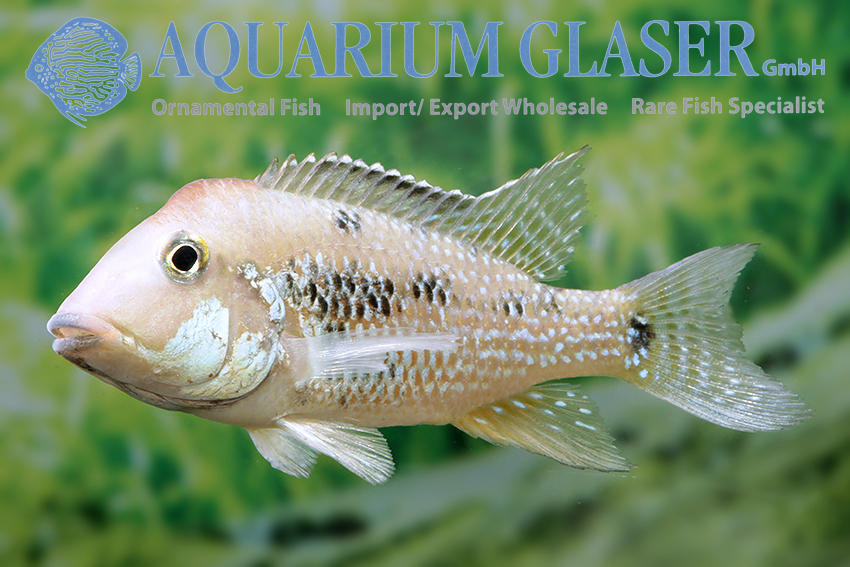
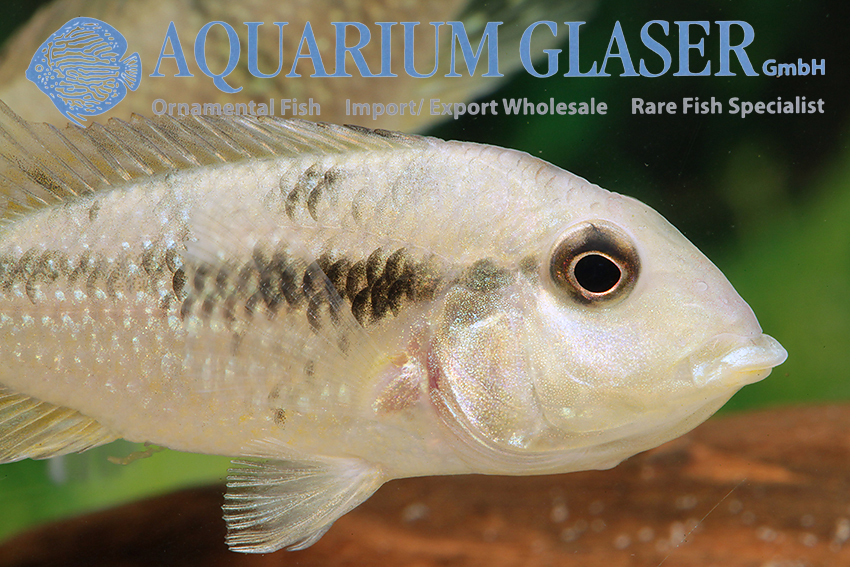
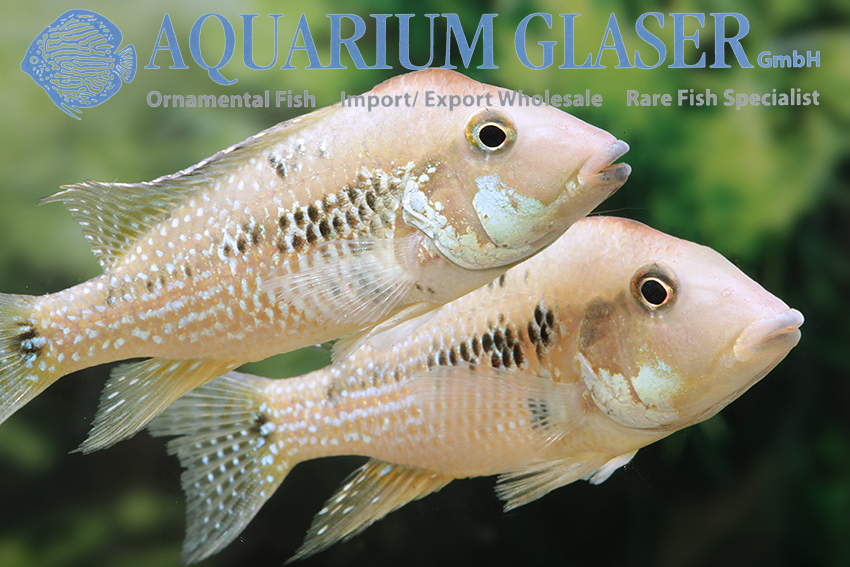
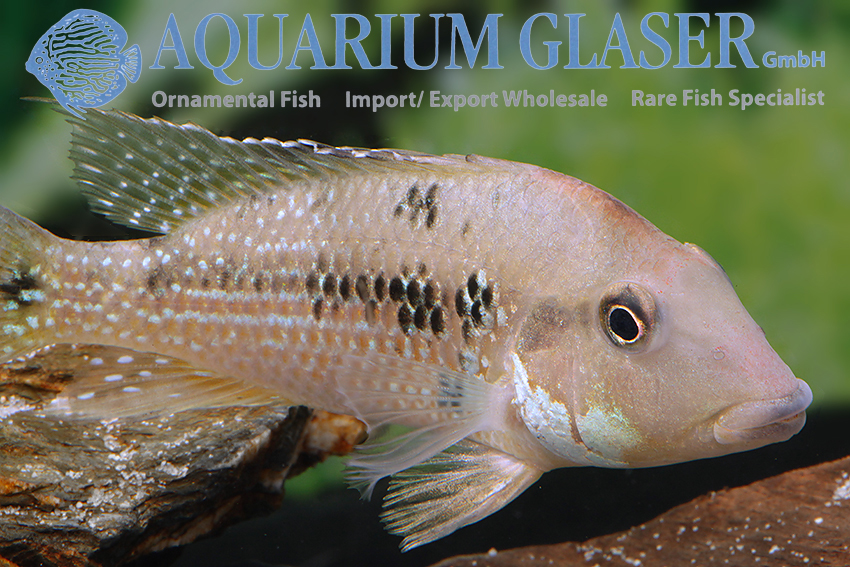
Geophagus steindachneri is considered to be the most specialized mouthbrooder of South America, because the eggs are taken into the maternal mouth immediately after spawning. Instead of egg spots in the anal fin, as found in many African mouthbrooding cichlids, G. steindachneri have orange spots in the corners of the mouth, which achieved the same effect.
We have at the moment nice offsprings of the species in the stock, where the males have as a special feature green-golden areas in the area of the gill covers.
For our customers: the animals have code 678212 on our stocklist. Please note that we supply exclusively to wholesalers.
Text & photos: Frank Schäfer
Apistogramma eremnopyge
When this beautiful Apistogramma first arrived in January 2003, we were thrilled. At that time we wrote:
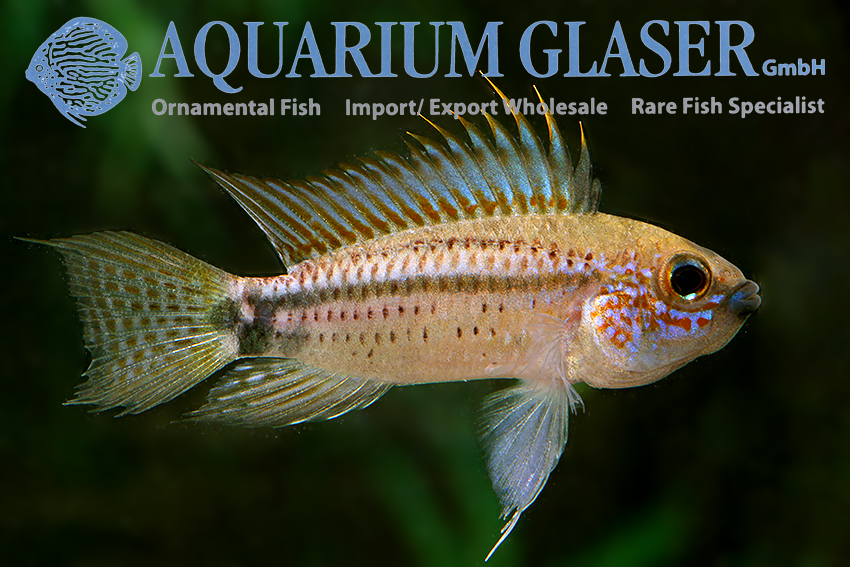
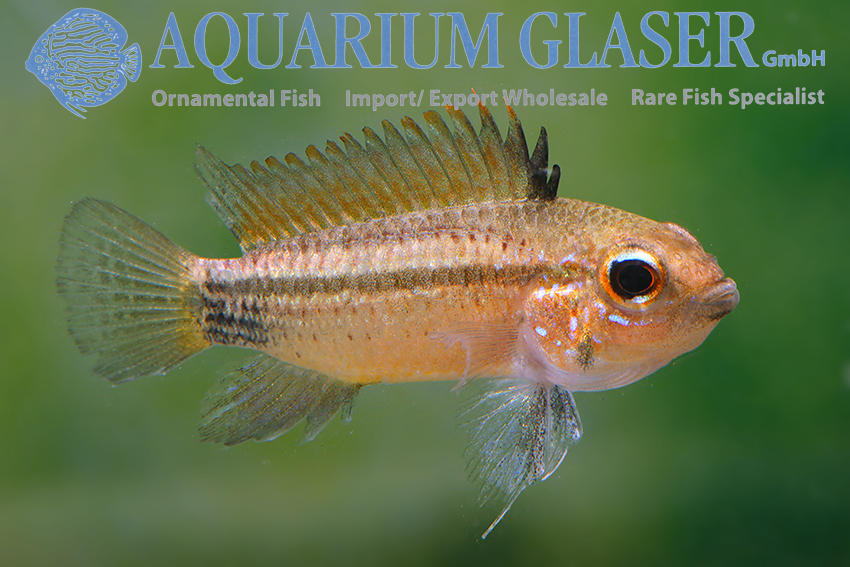
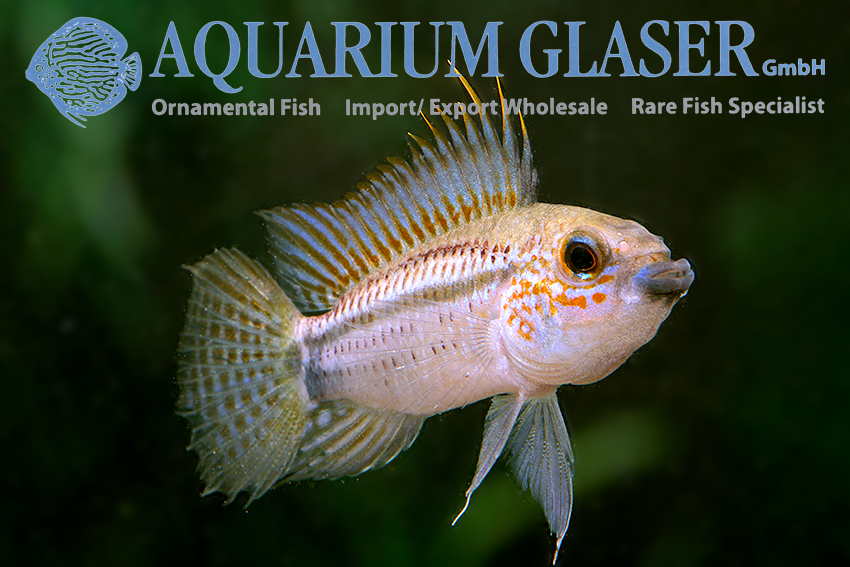
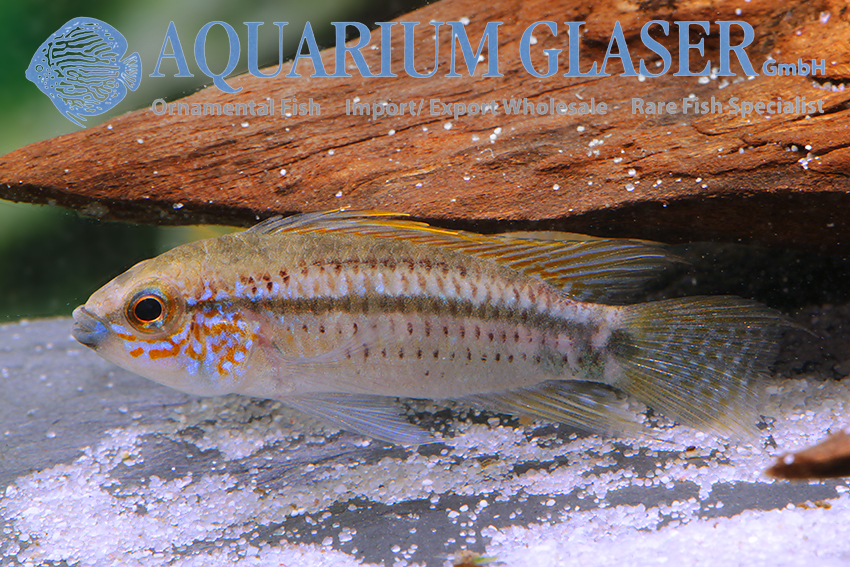
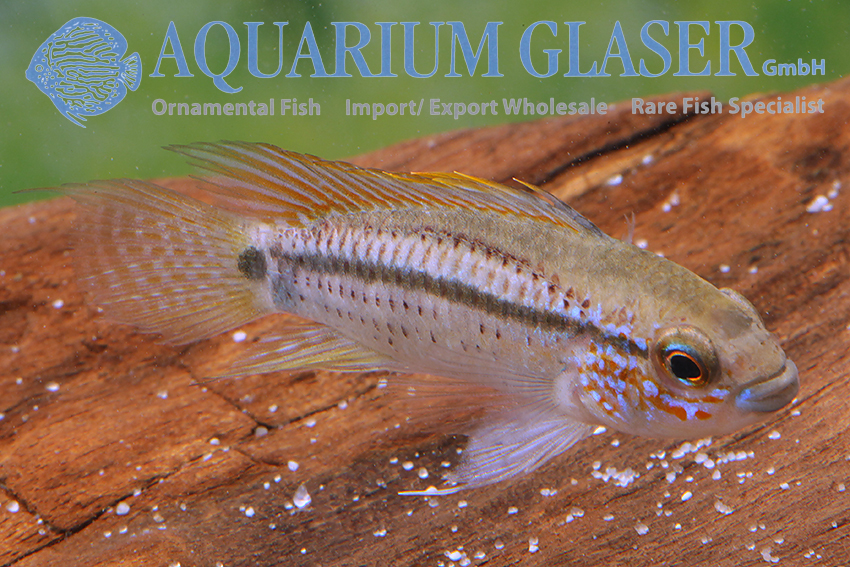
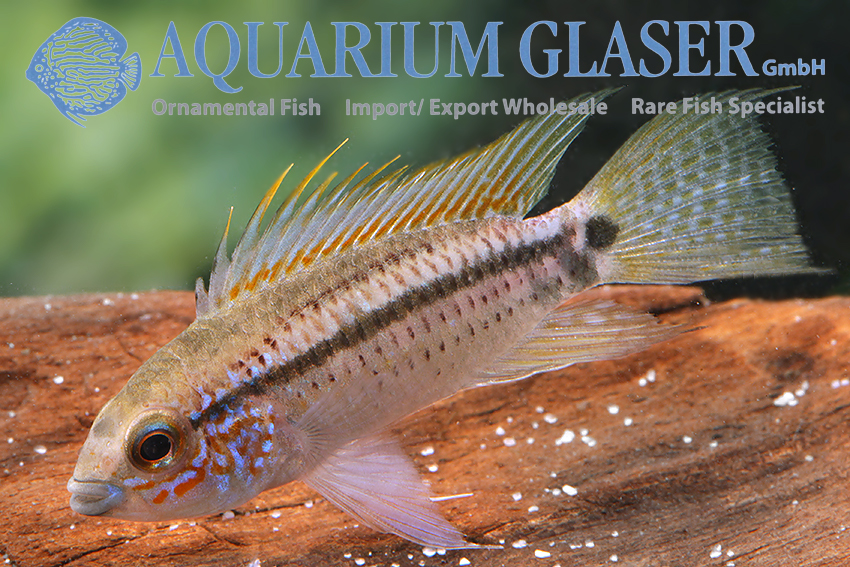
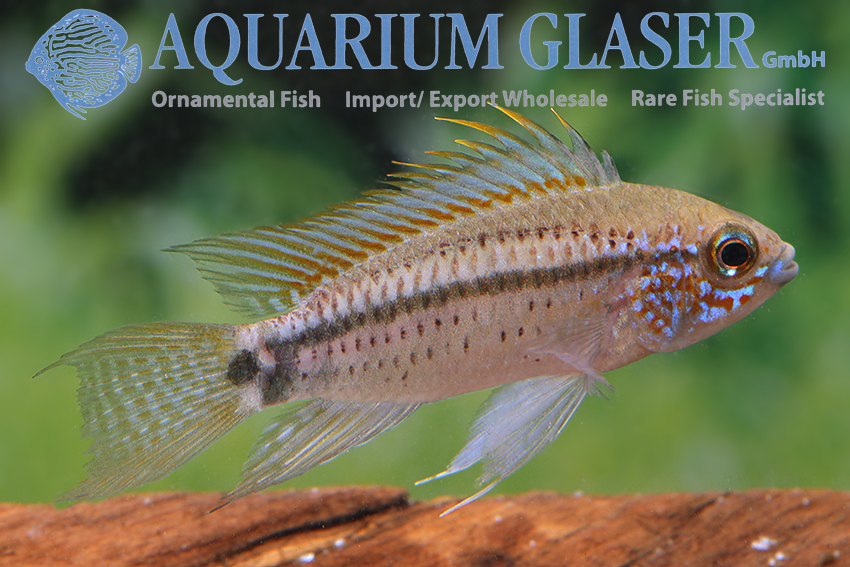
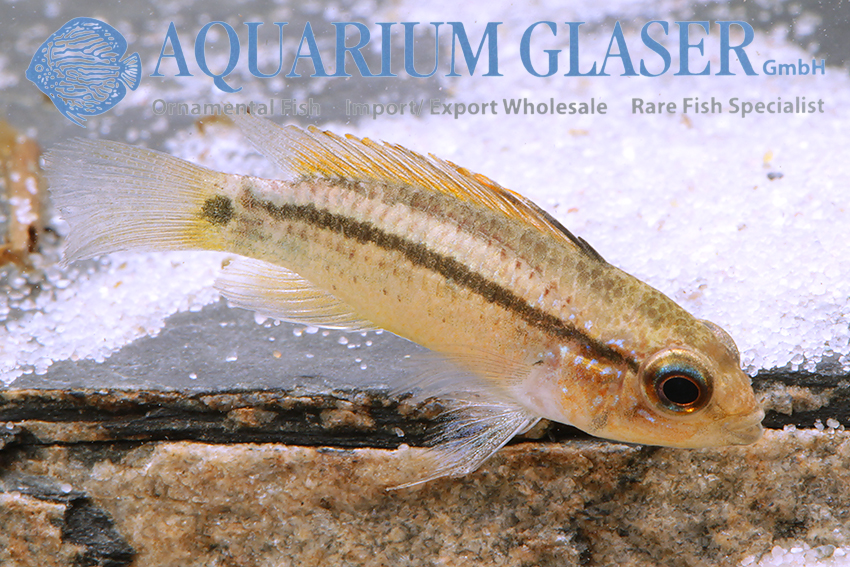
„King Barbarossa lives!
A new, wonderful dwarf cichlid has now been imported from Peru for the first time. The species is still unknown both scientifically and aquaristically.
The species is collected in the Tapiche river, a tributary of the Ucayali river, near Requena. Mr Edgard Panduro named the species Apistogramma “BARBAROJA”, i.e. “red beard”, because of the conspicuous red spots on the face. While in the last time mainly new species and new variants around Apistogramma cruzi and A. nijsseni made the hearts of the dwarf cichlid fans beat faster, this Apistogramma is from a completely different site. It reminds in various respects of A. bitaeniata, which is also one of the most beautiful Apistogramma species. At first sight, however, the new “Redbeard” can be distinguished from all known Apistogramma species by the large tail spot, which has not yet become known from any dwarf cichlid in this form.“
Then, in July 2004, Ready and Kullander described the species as Apistogramma eremnopyge based on specimens collected two years earlier by Oliver Lucanus in the Rio Pintuyacu (drainage of the Rio Itaya), 48 km on the road from Iquitos to Nauta (Loreto Province in Peru).
Since then, unfortunately, it has become quite quiet about this pretty little fish. Sexually mature wild specimens are usually not larger than 5 cm, females always stay smaller, but it is of course possible that the species grows a bit larger if kept in aquaria for a long time. In any case, it is a true dwarf cichlid.
We are very happy to have this species in our fishhouse again after a long time. Currently it is called Apistogramma “Diamond” in the trade, in the past it was sometimes called Apistogramma sp. “Fresa” or “Strawberry” (both mean strawberry).
For our customers: the animals have code 628792 on our stocklist. Please note that we only supply wholesale.
Text & photos: Frank Schäfer
- « Previous Page
- 1
- 2
- 3
- 4
- …
- 10
- Next Page »





